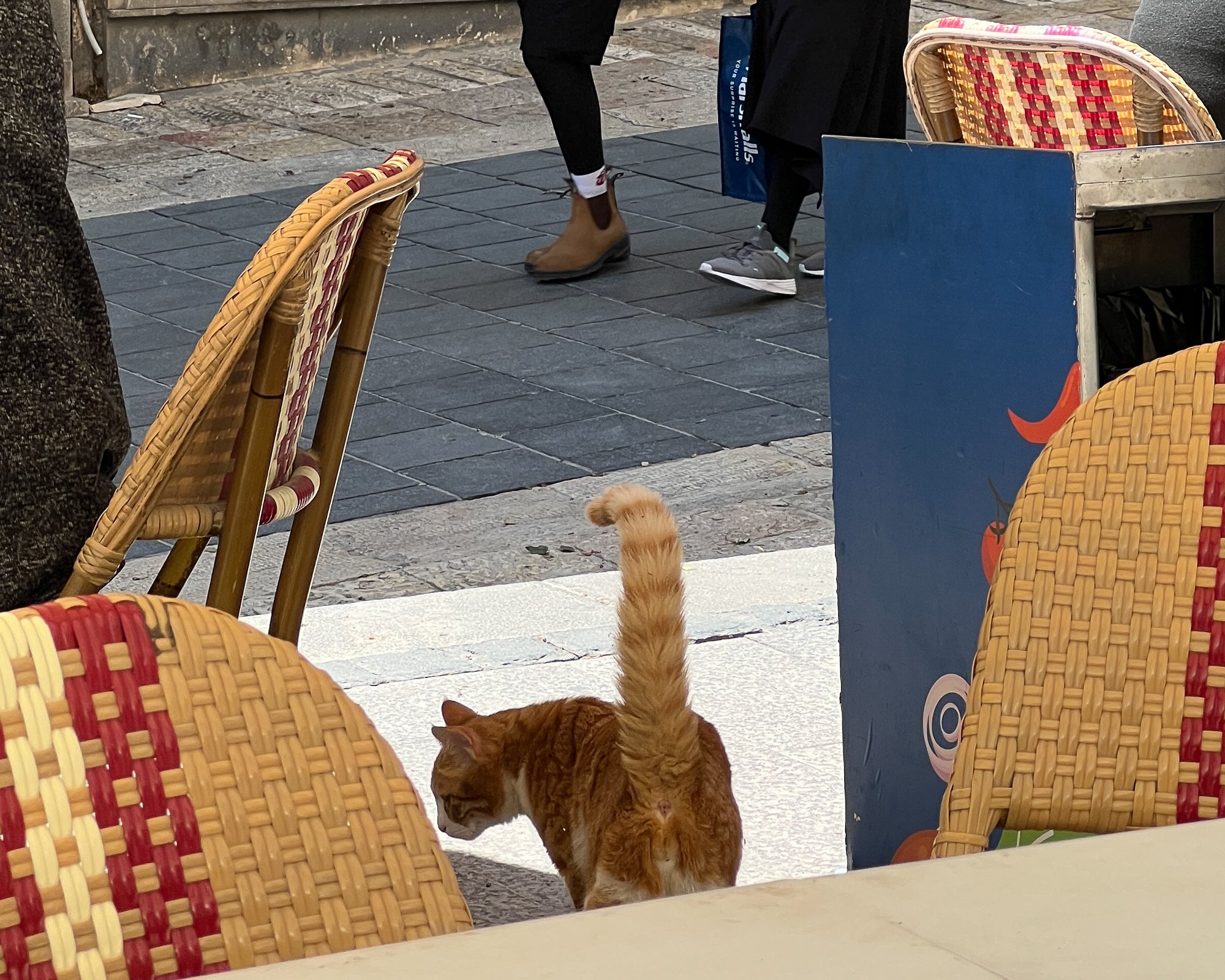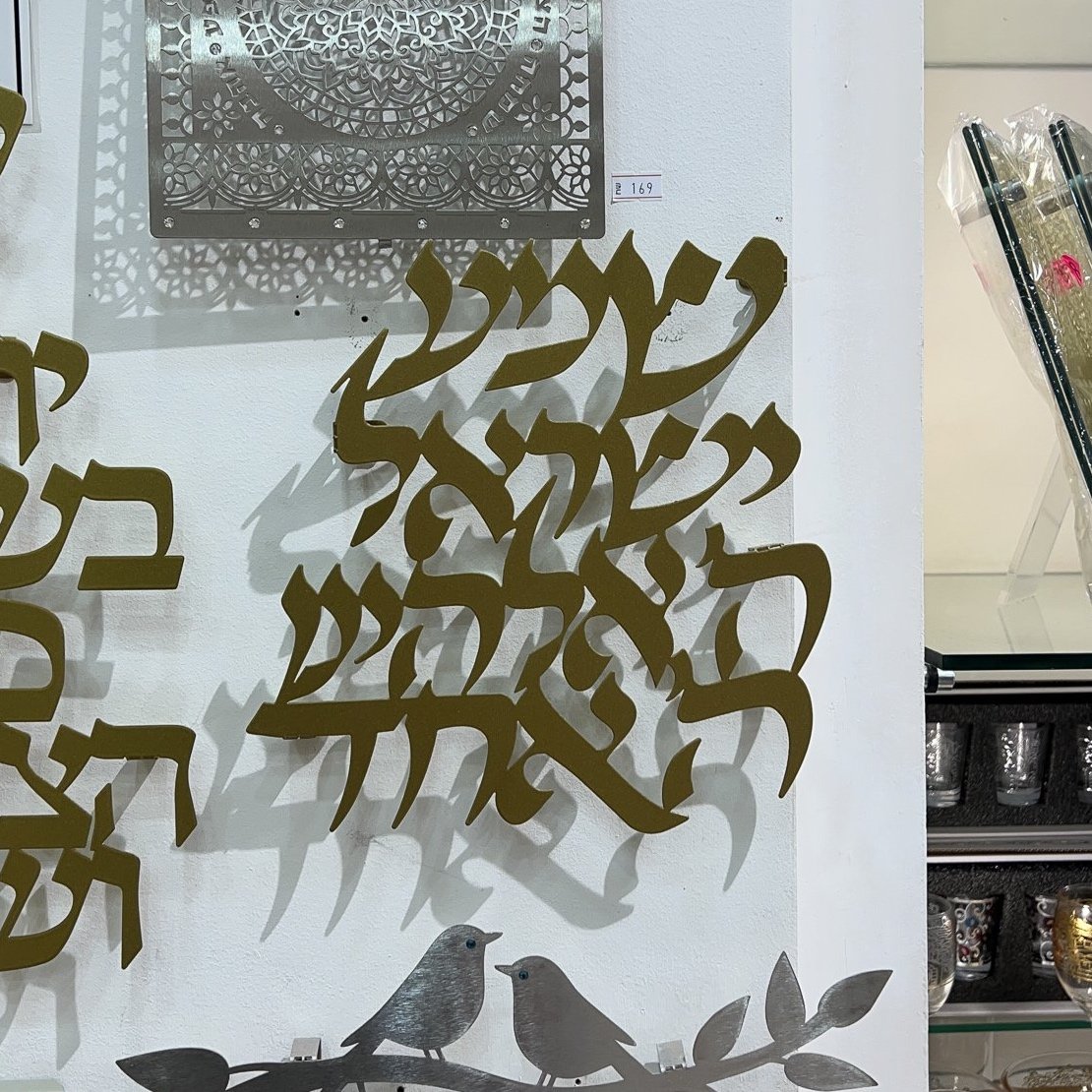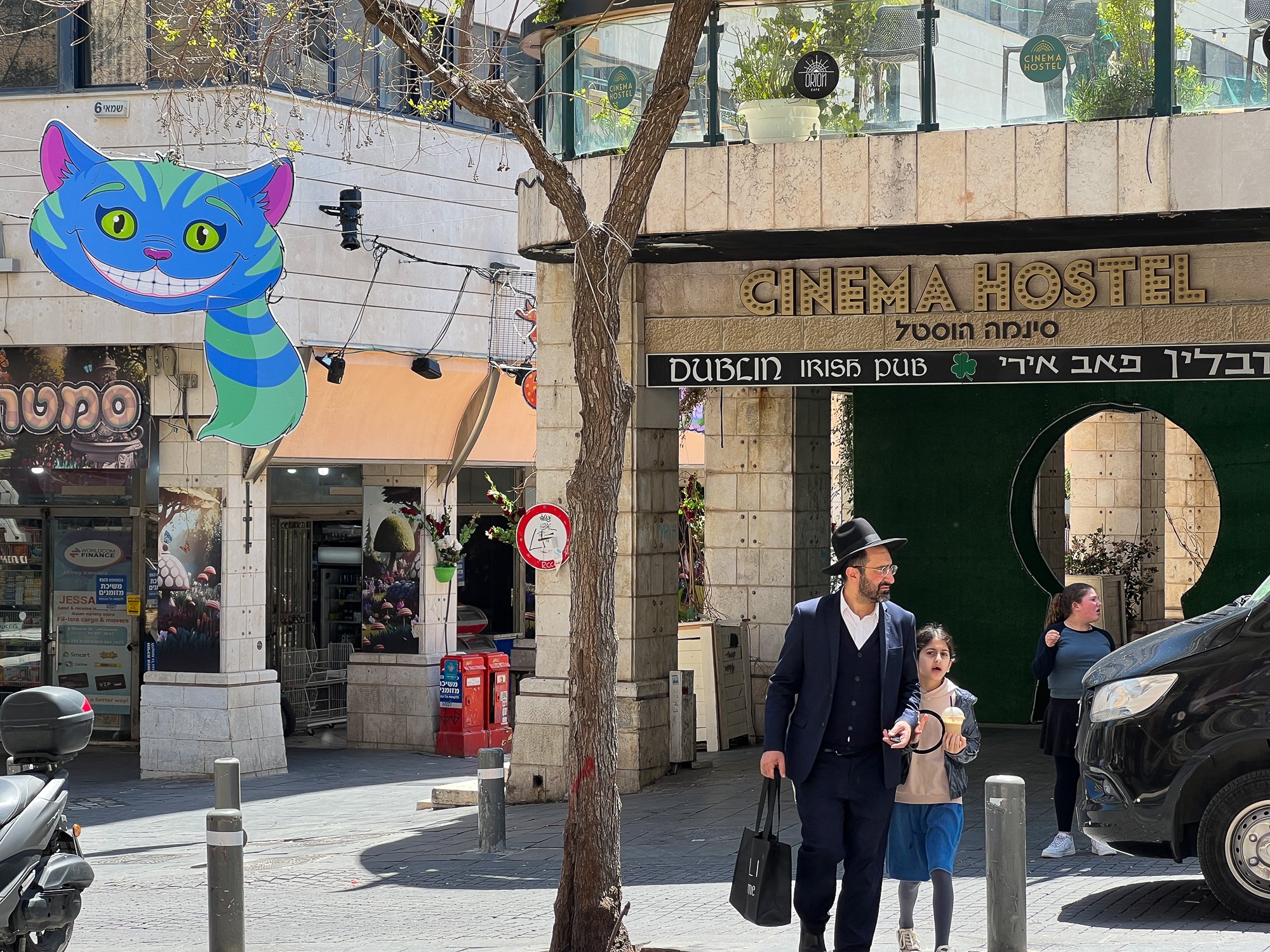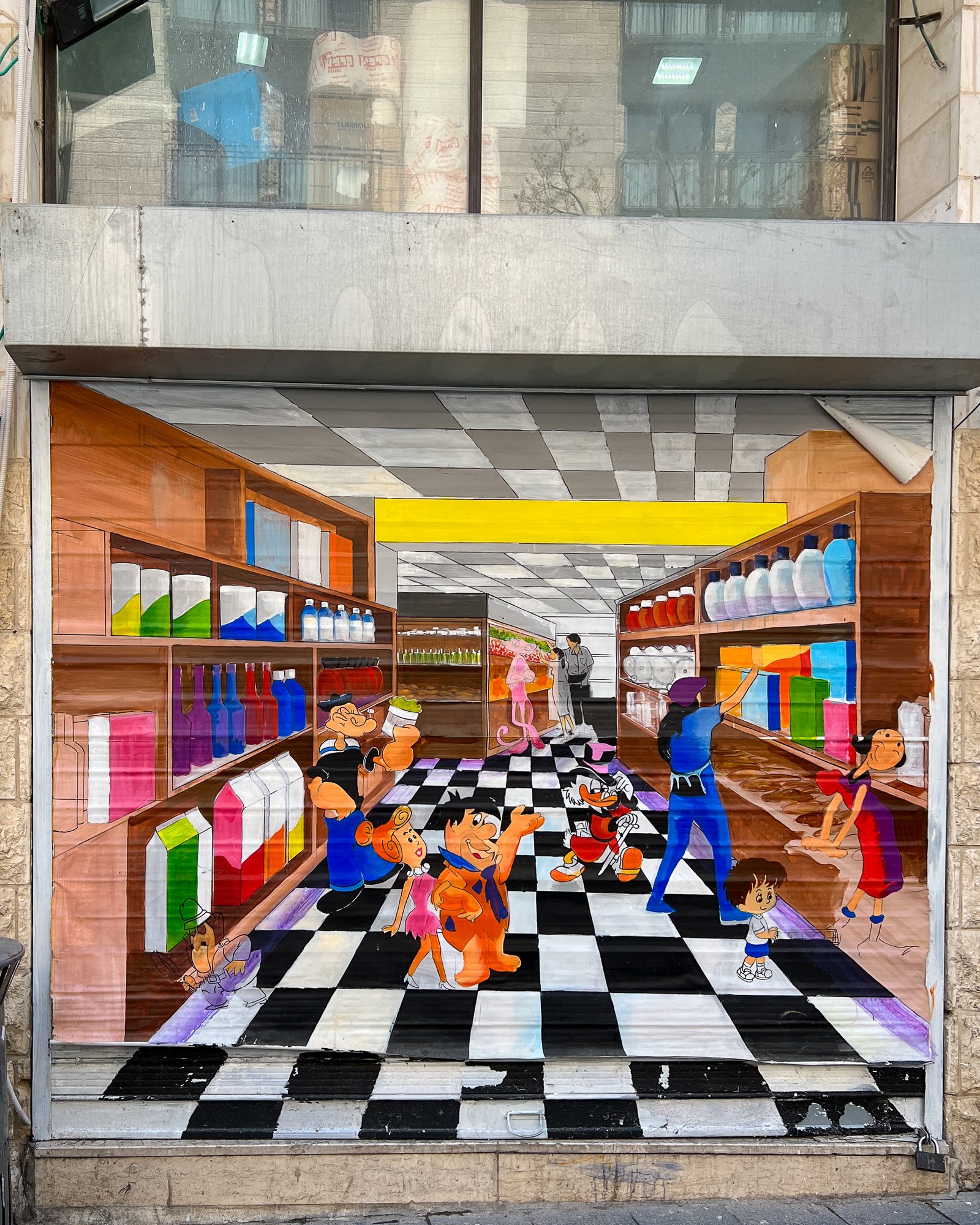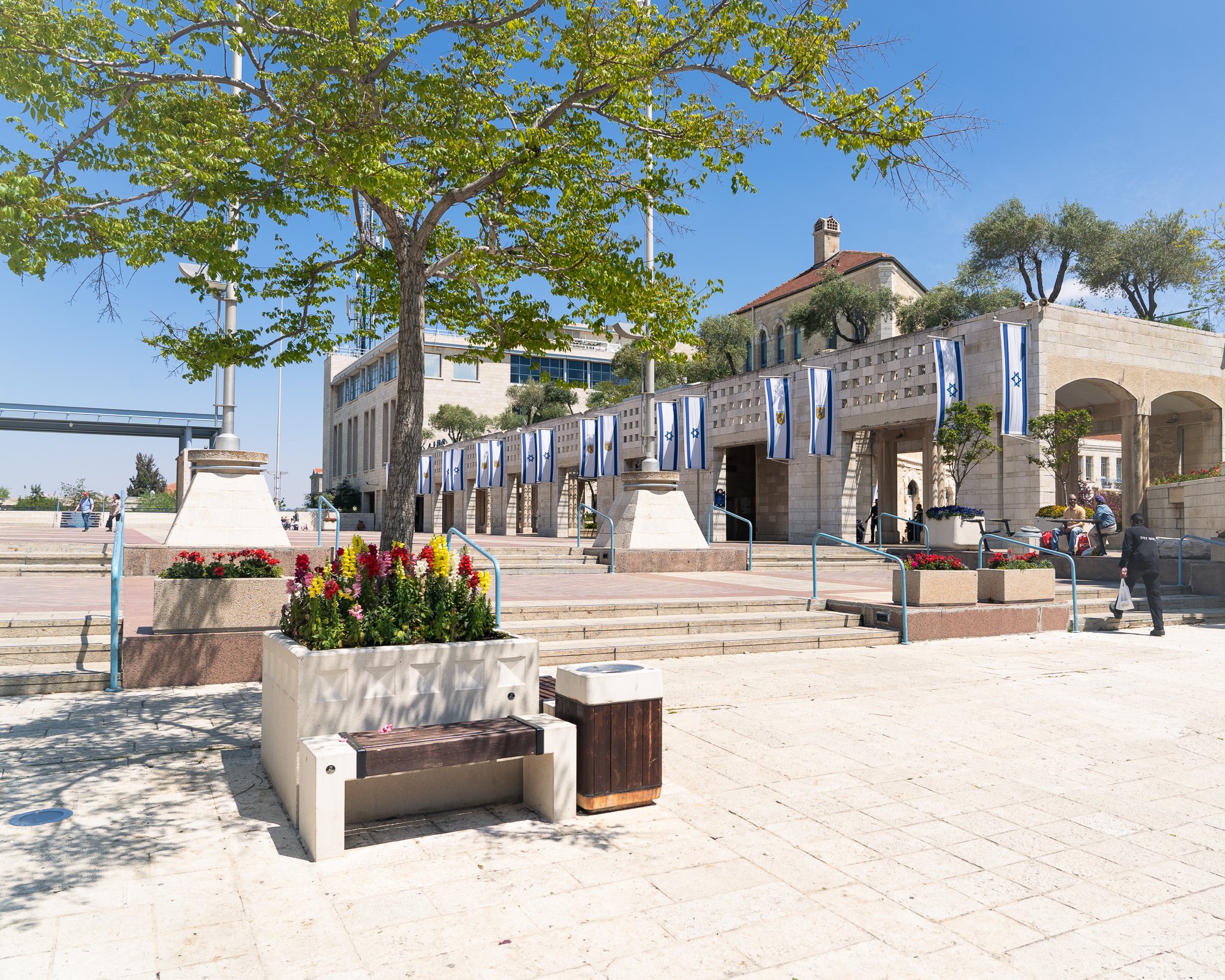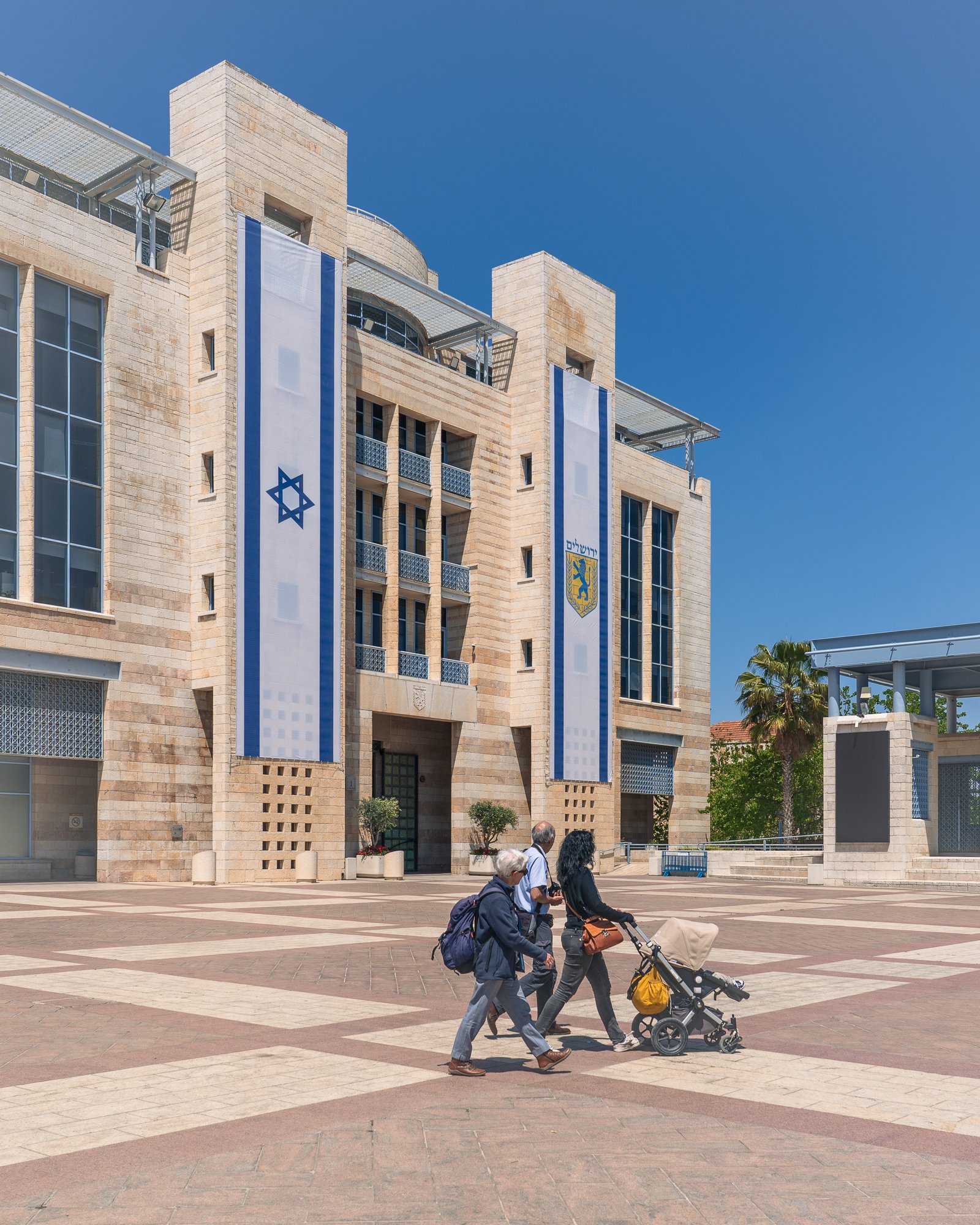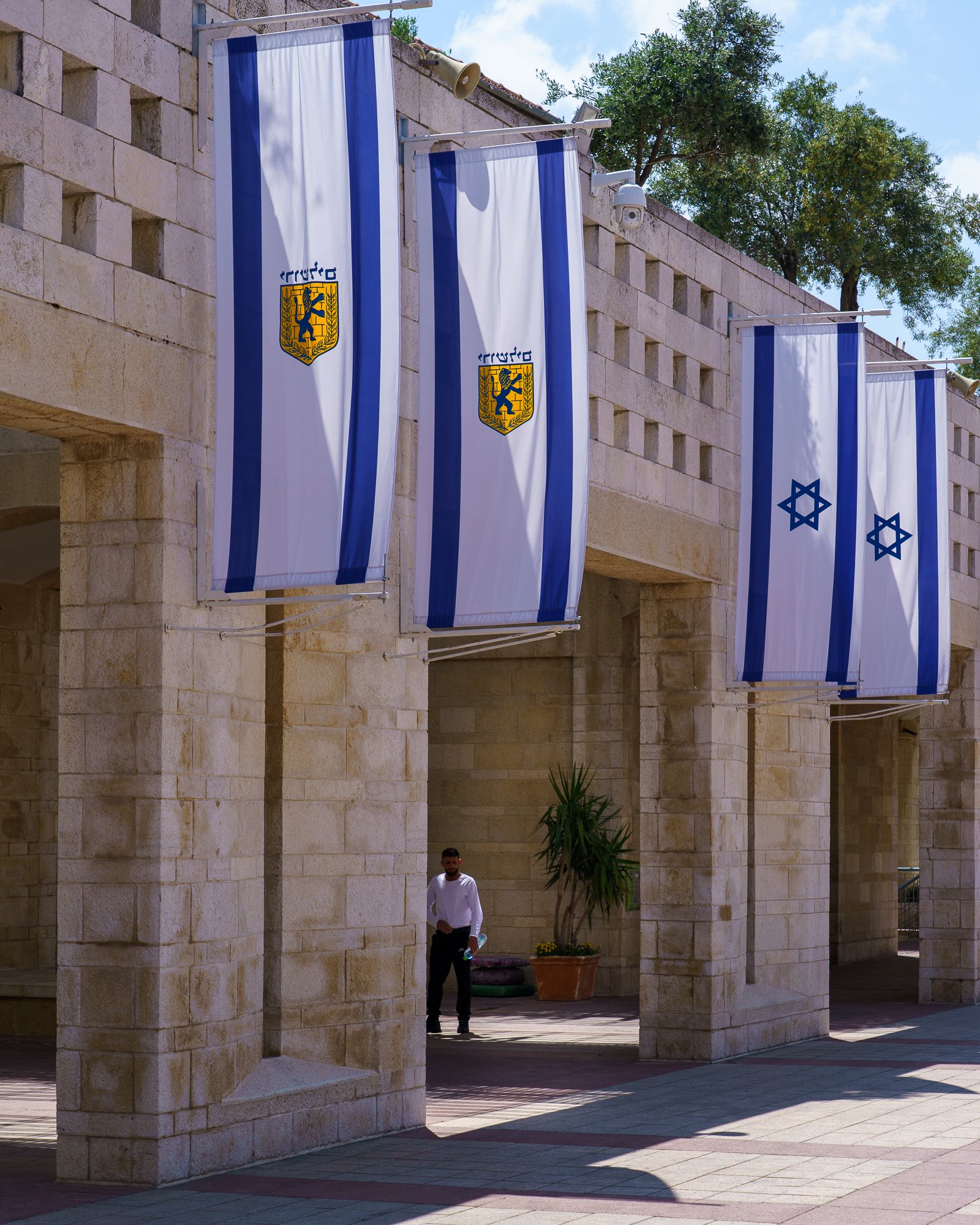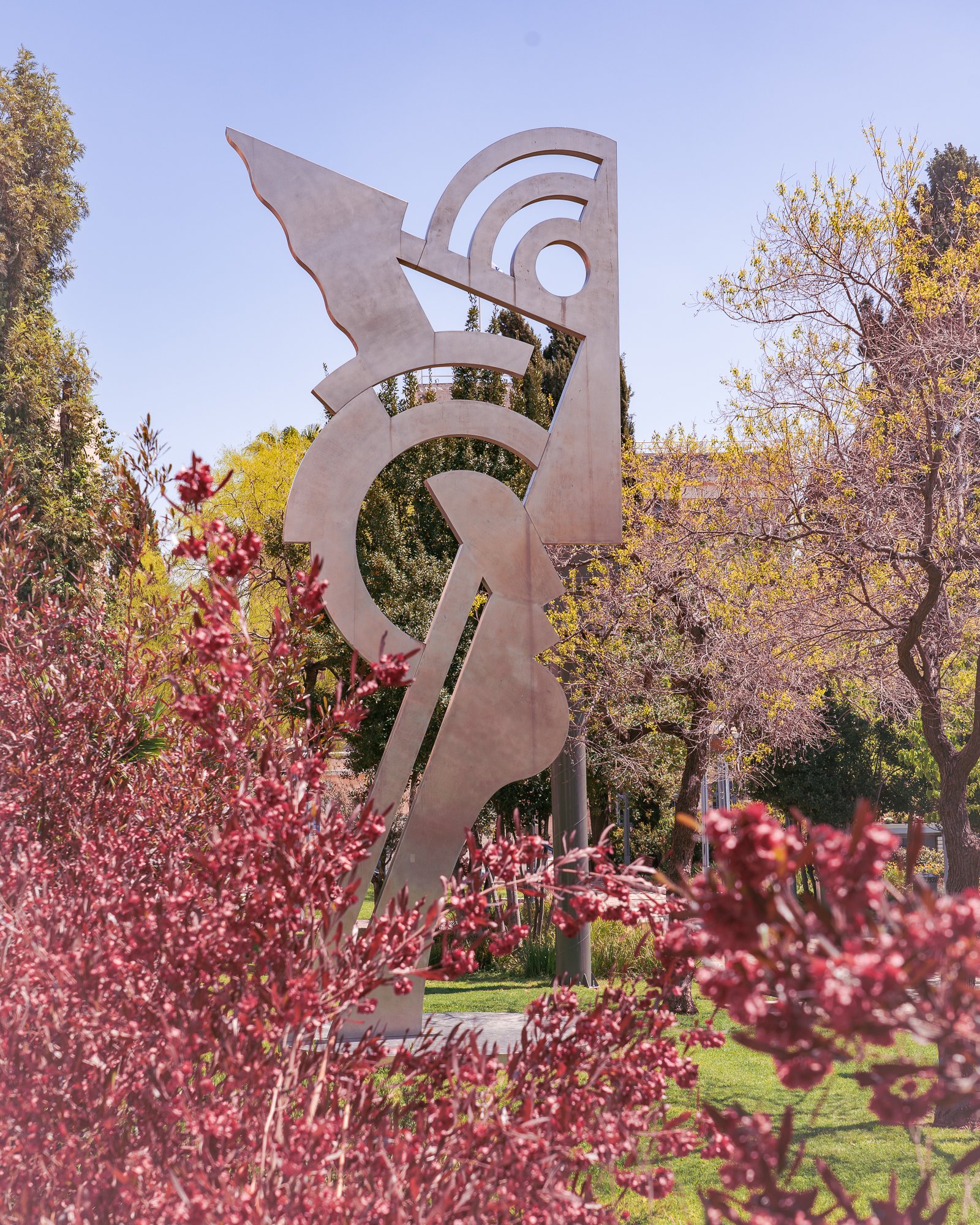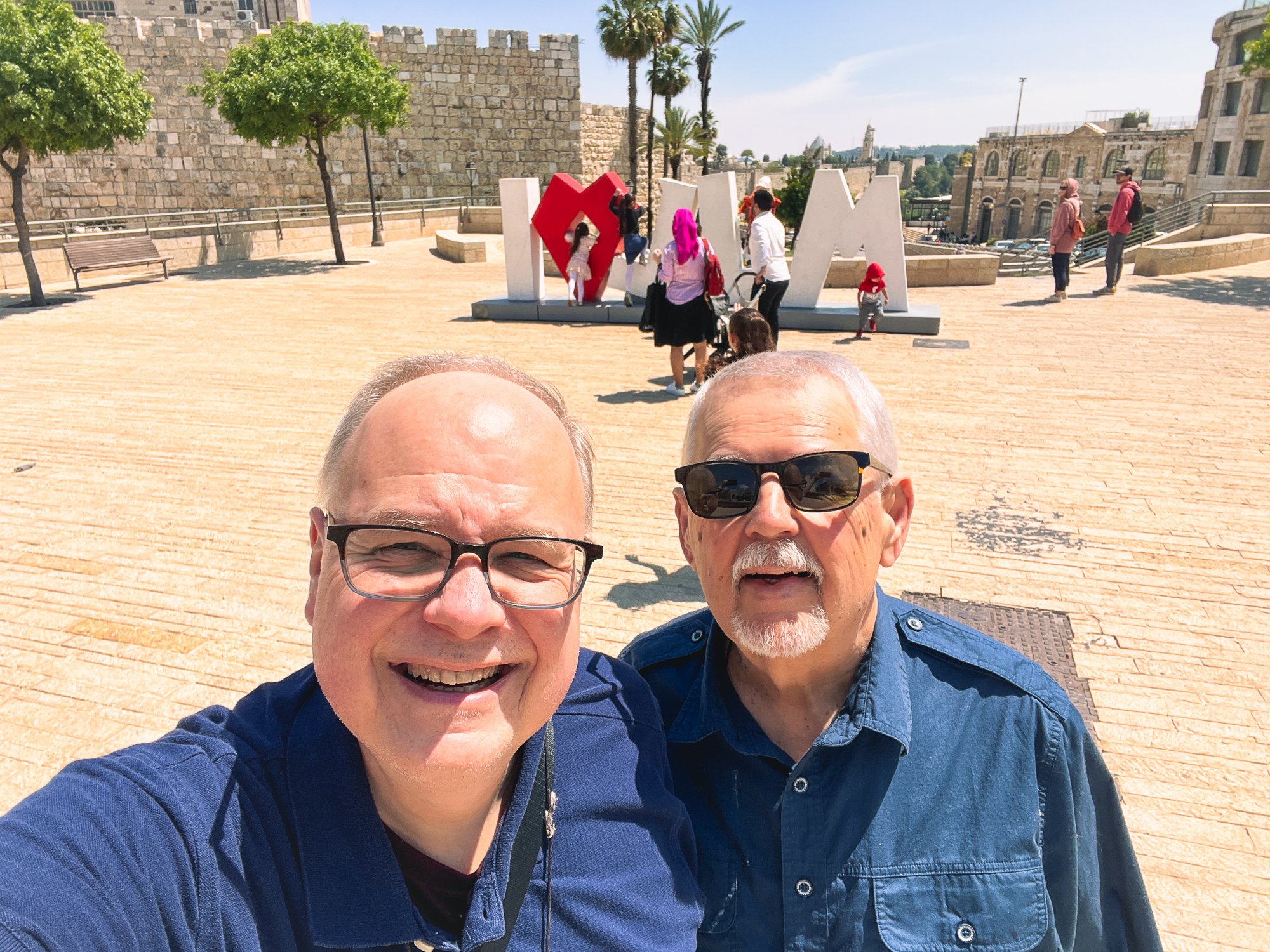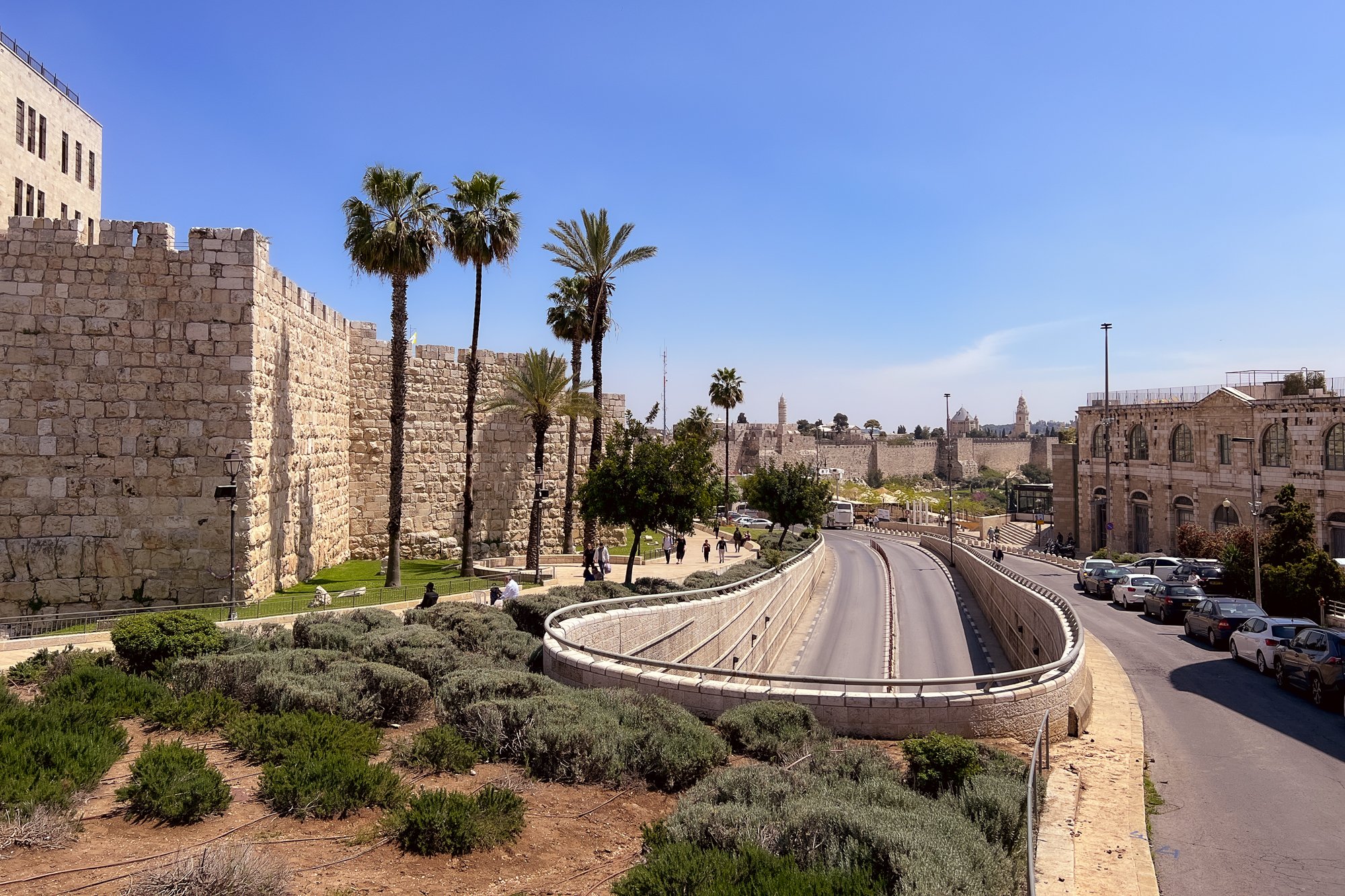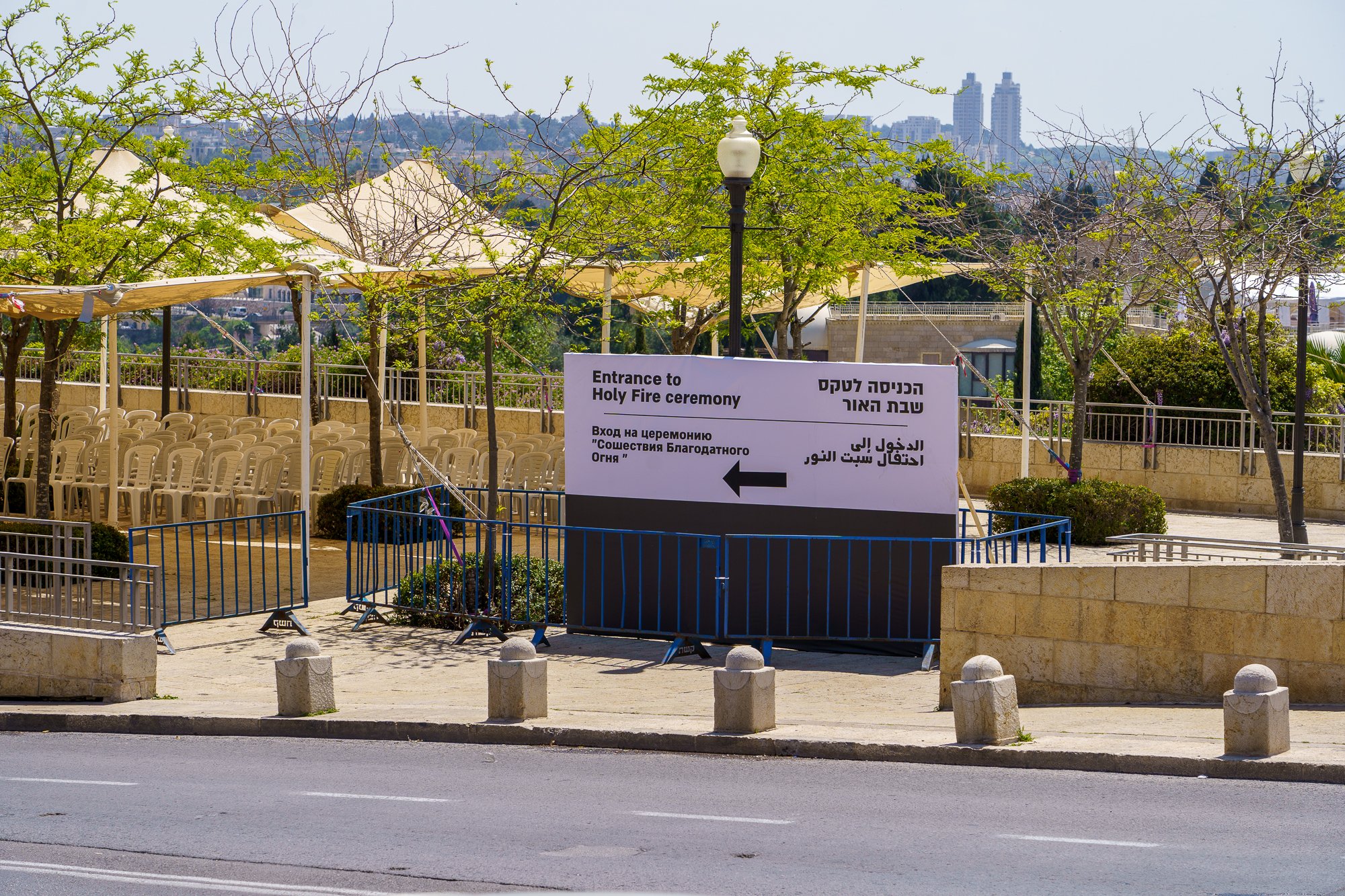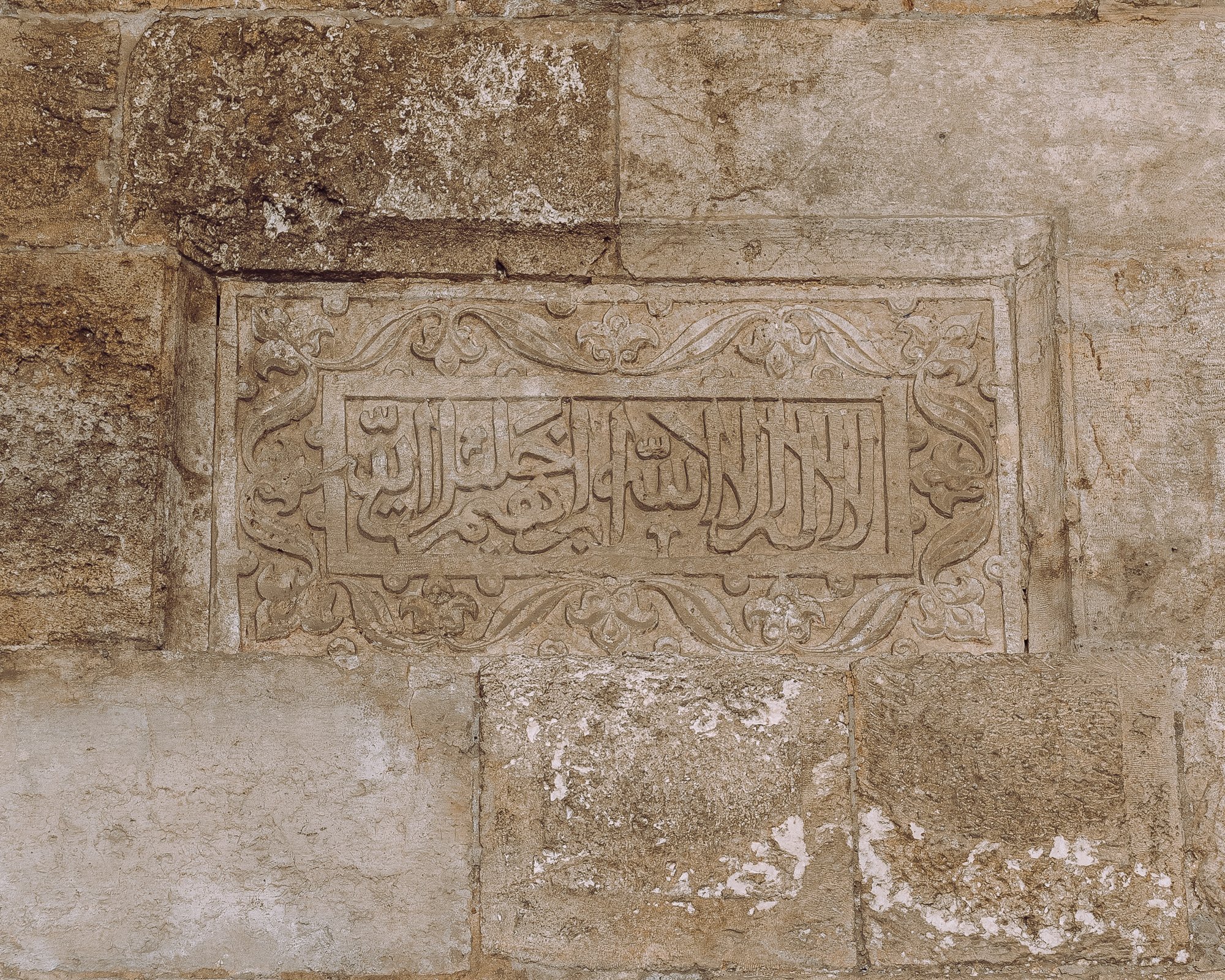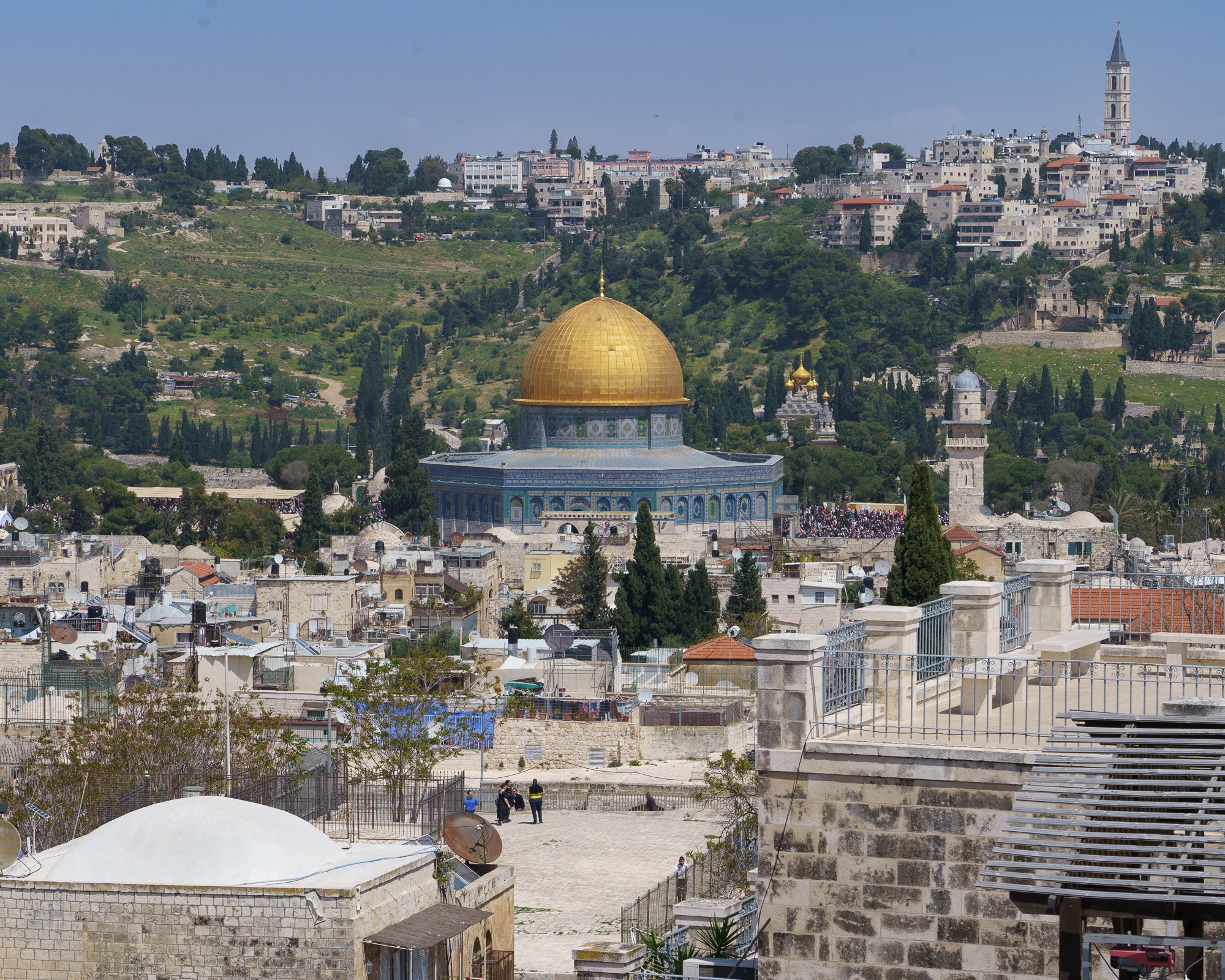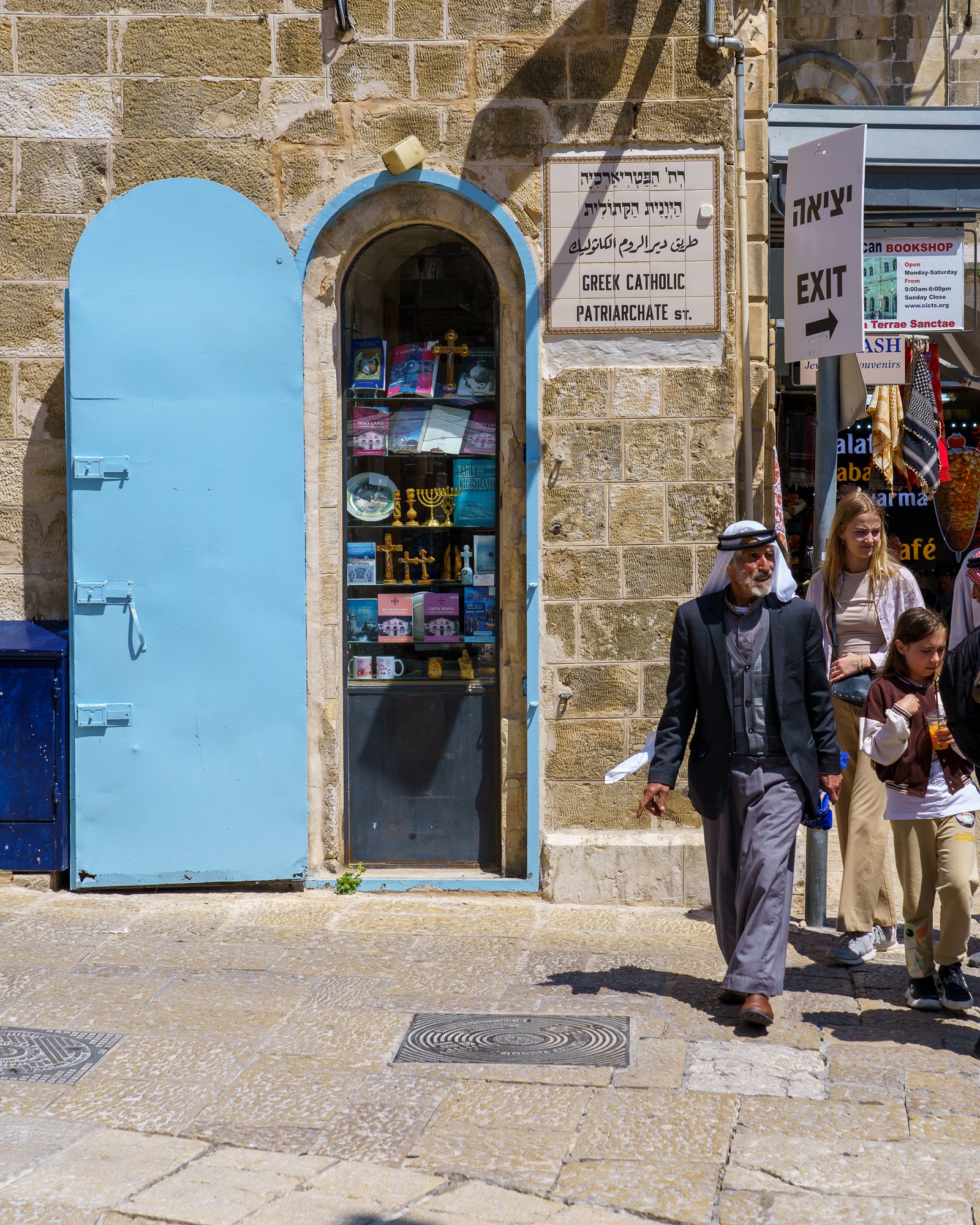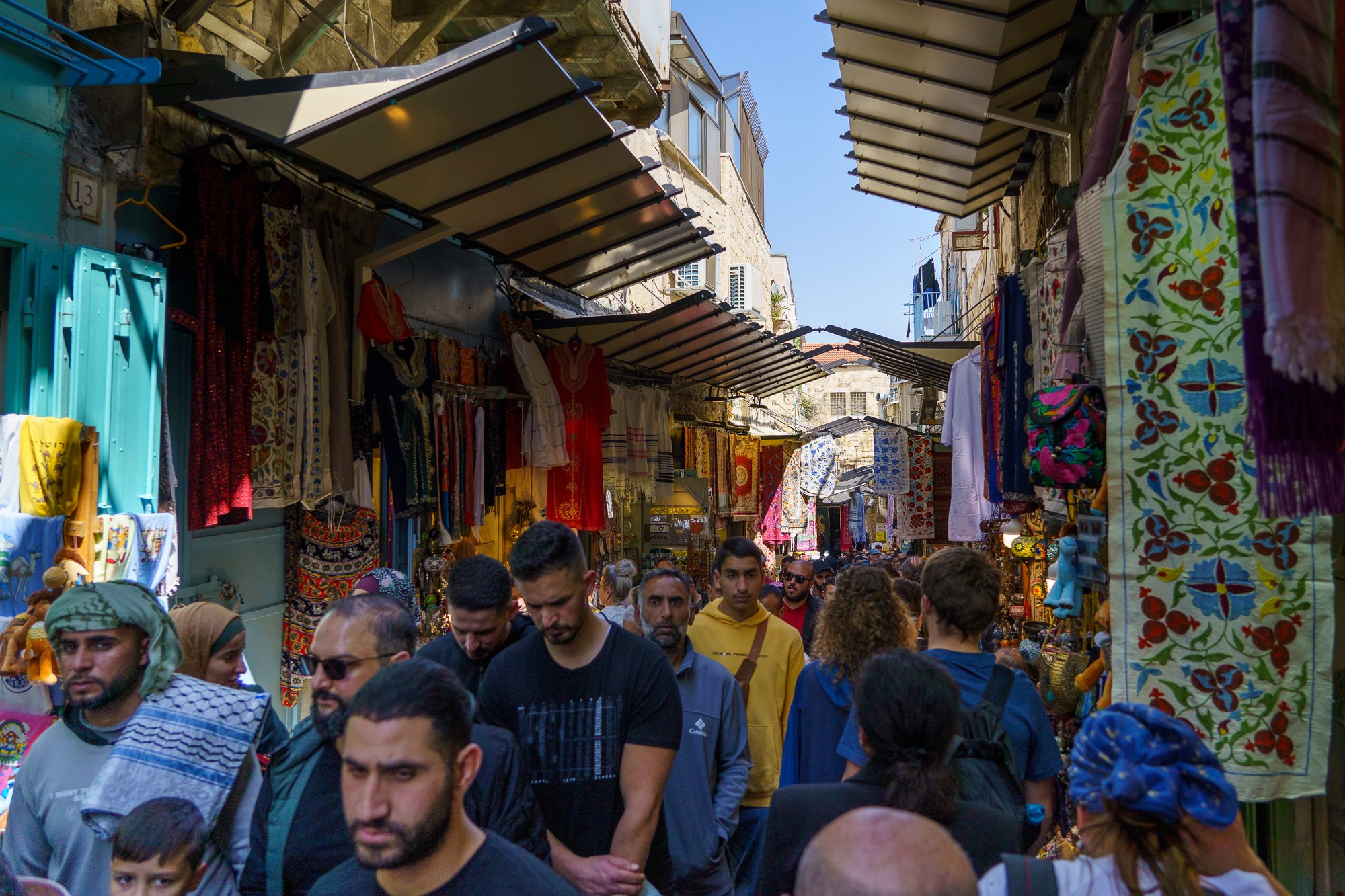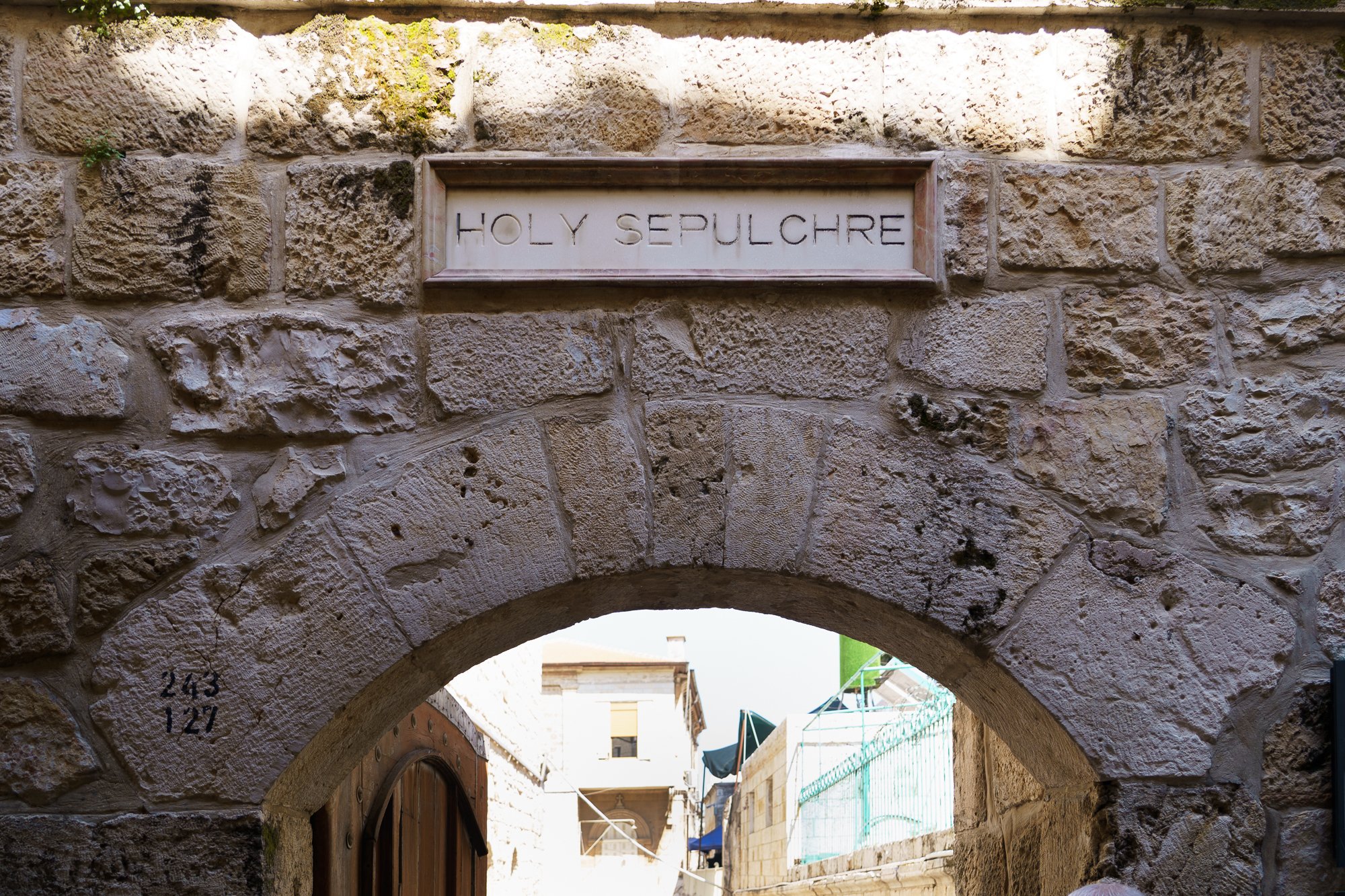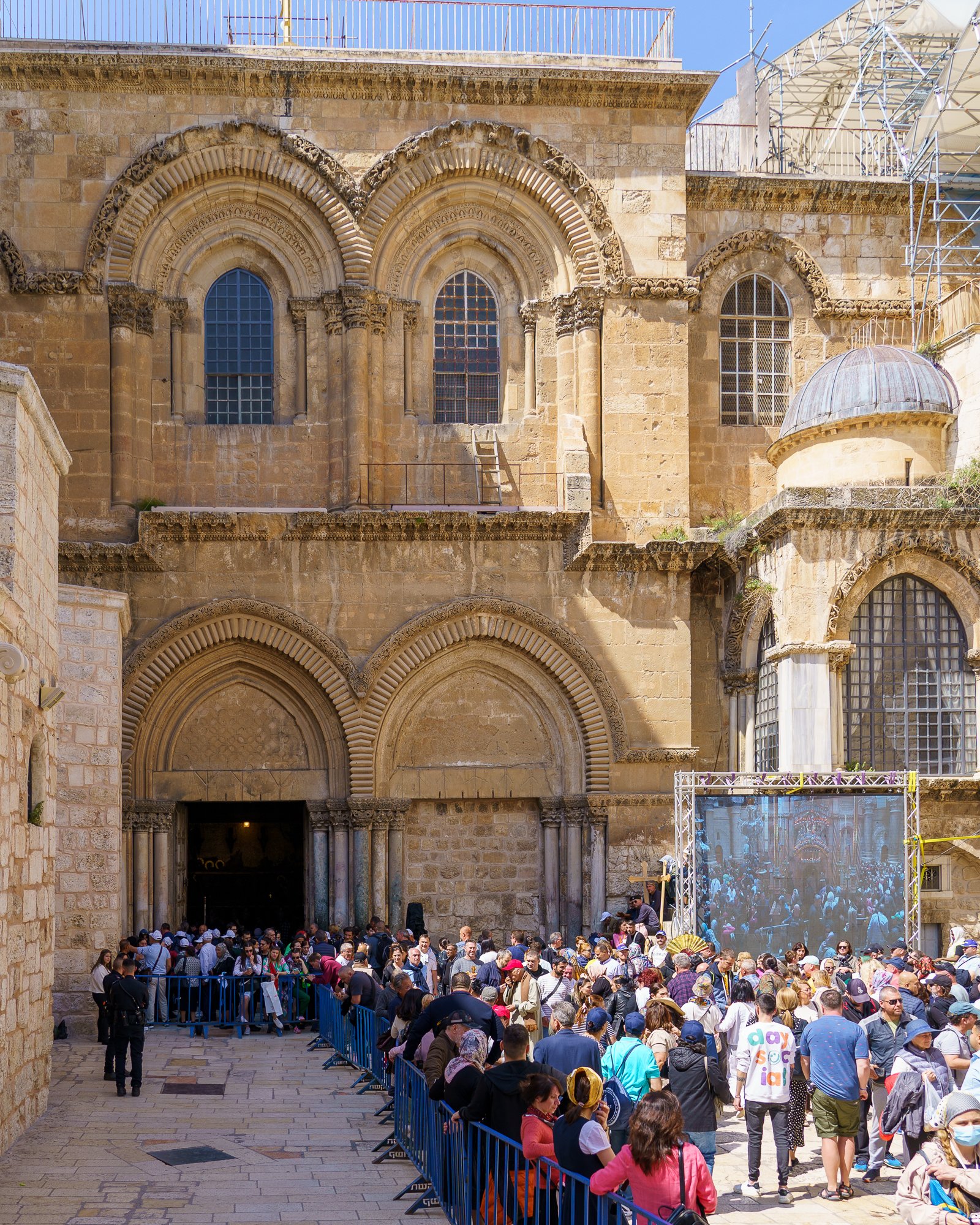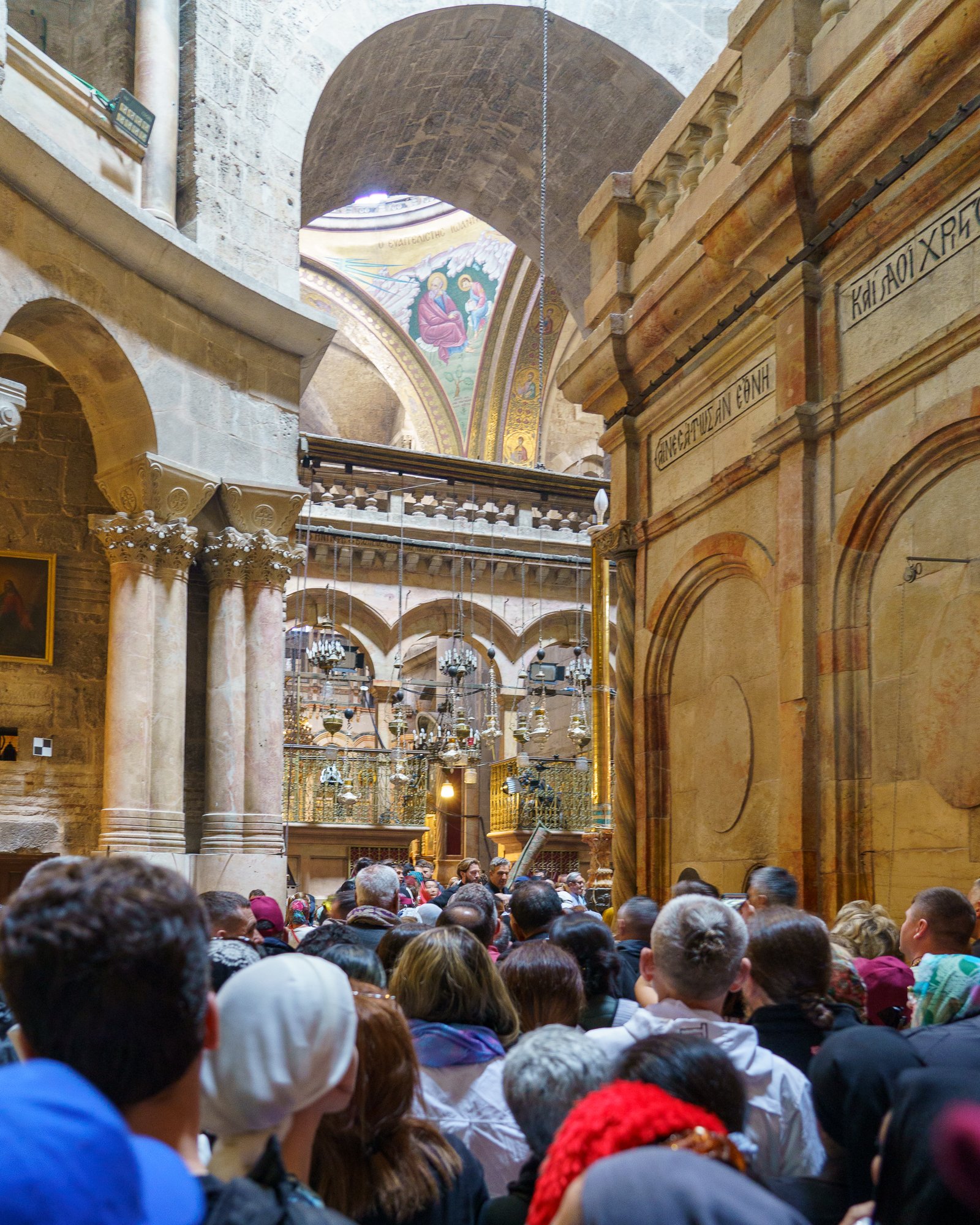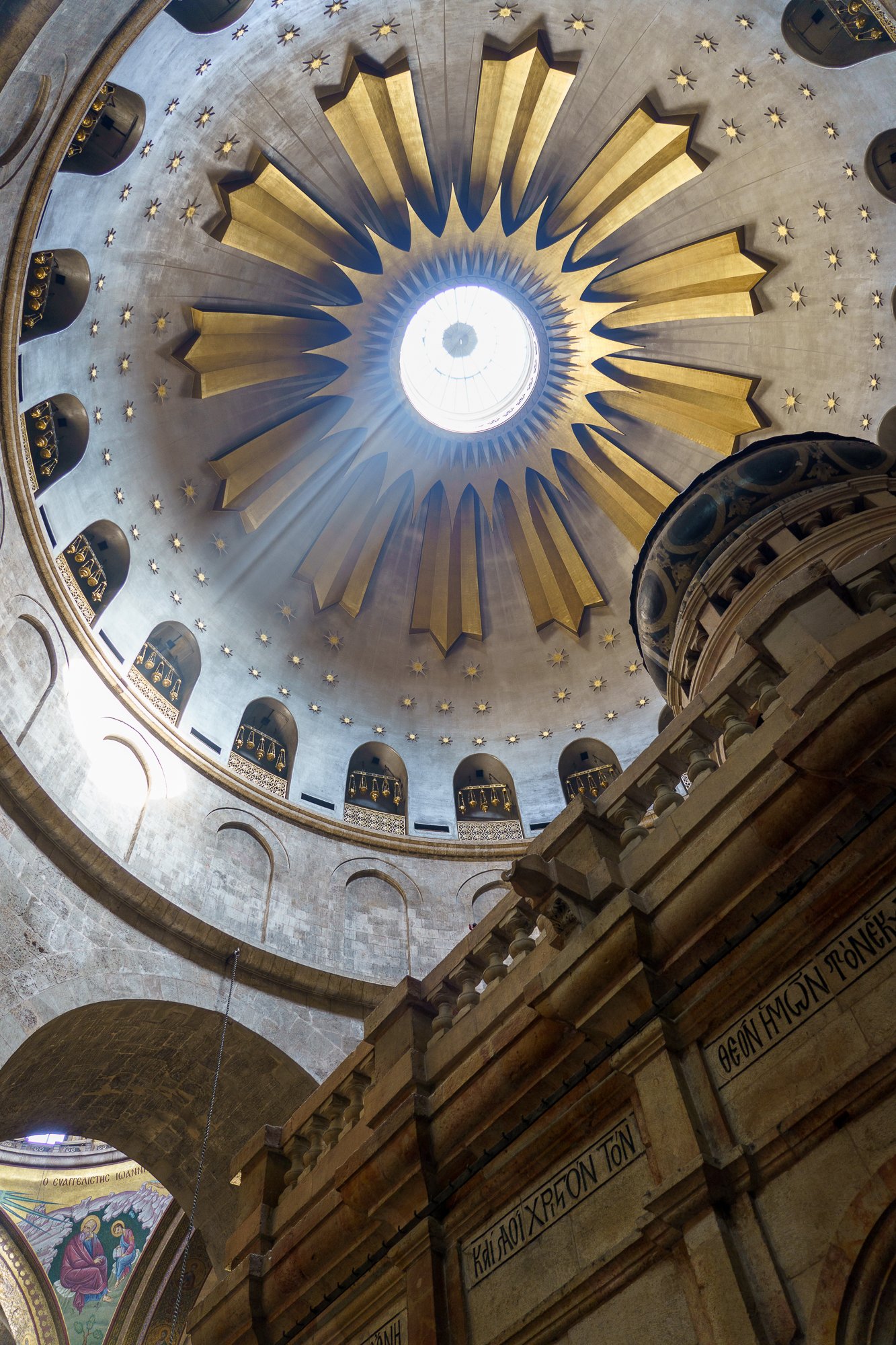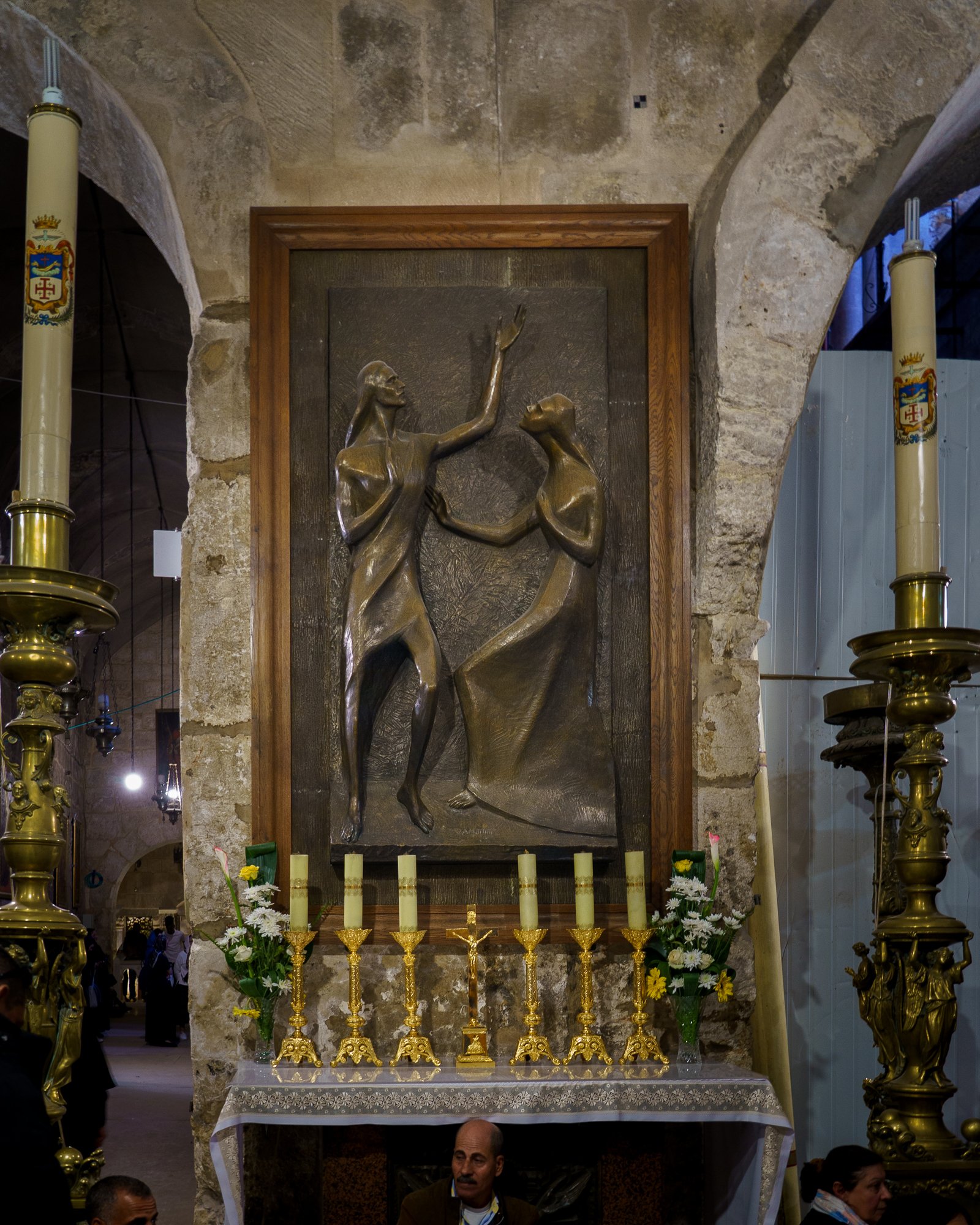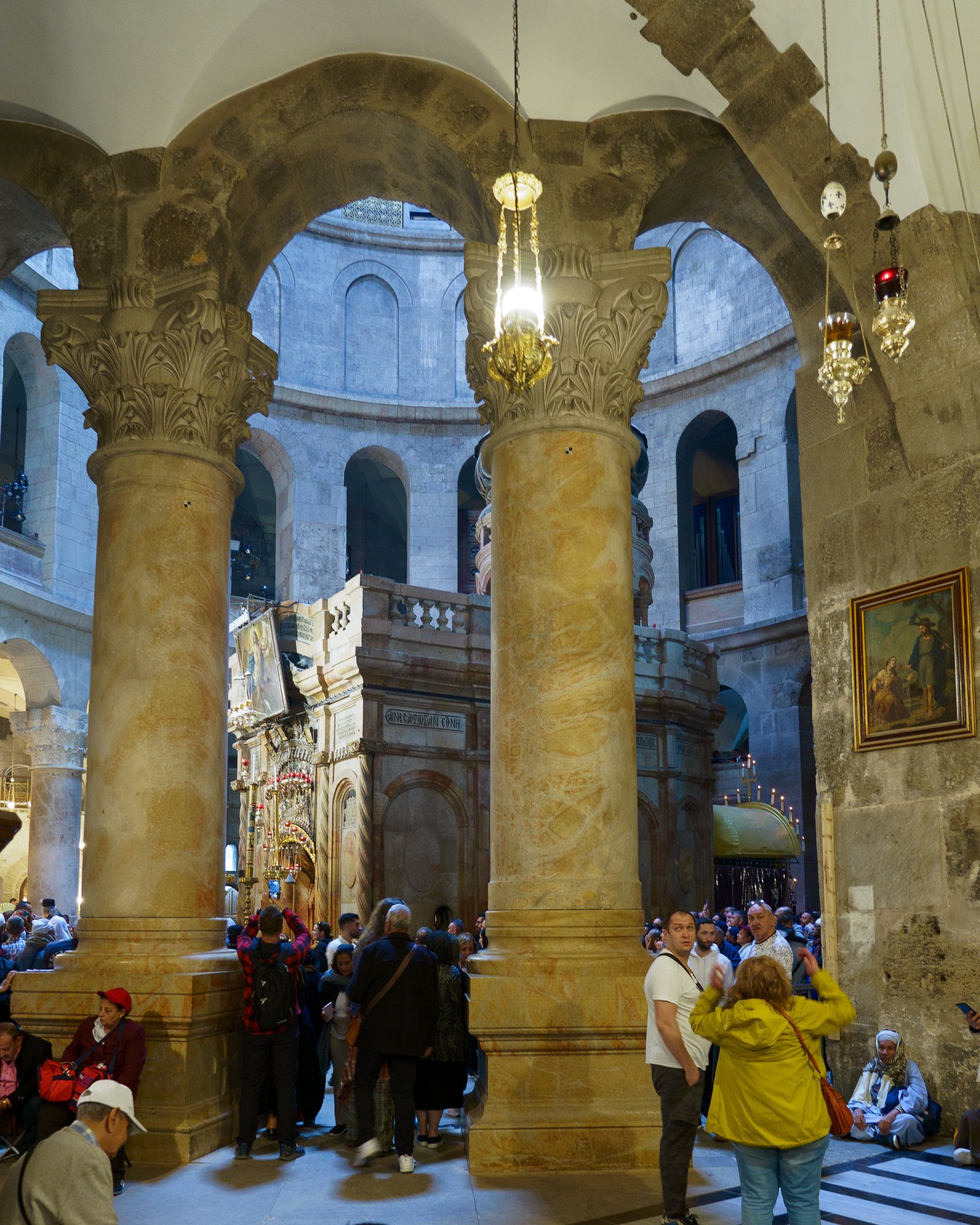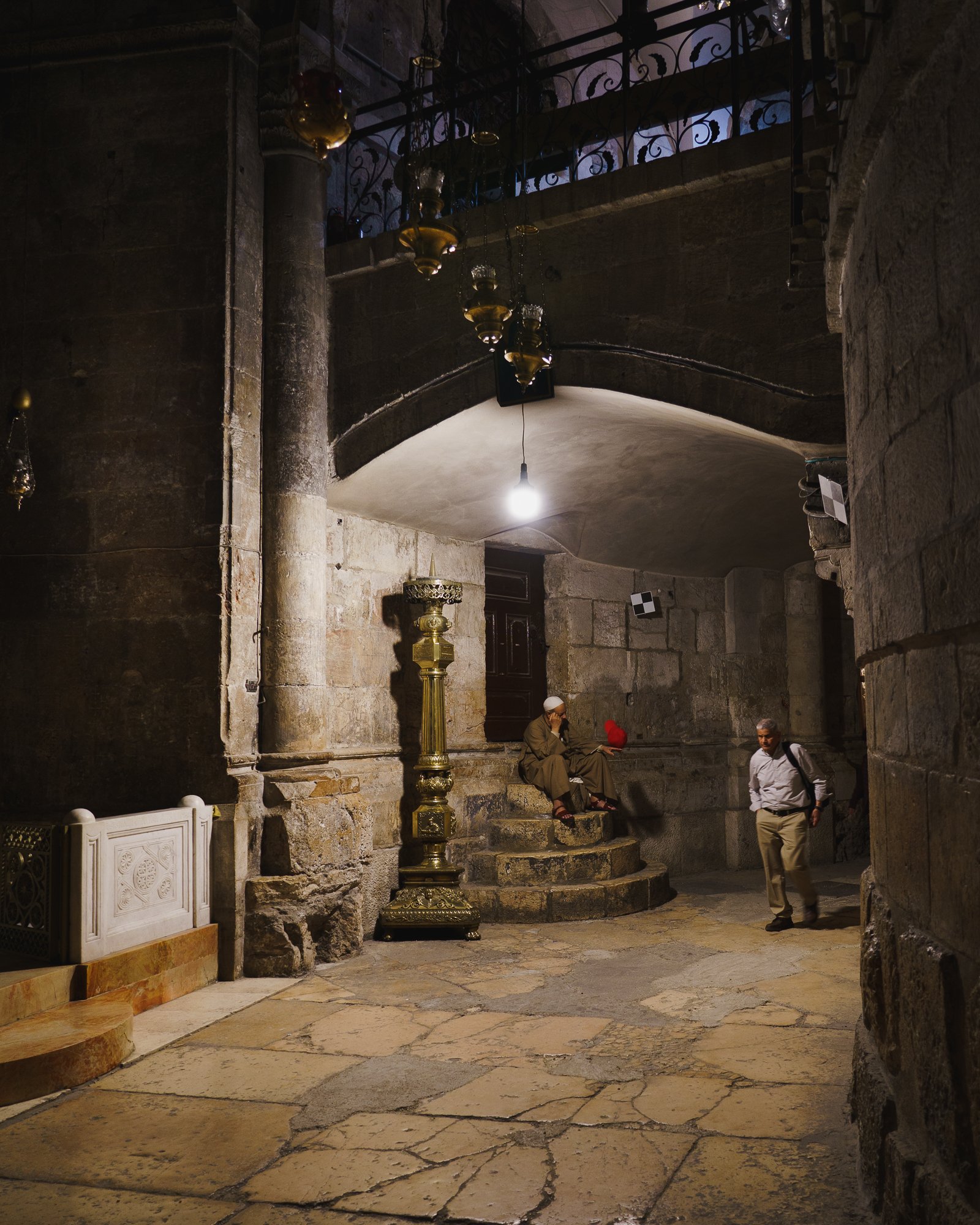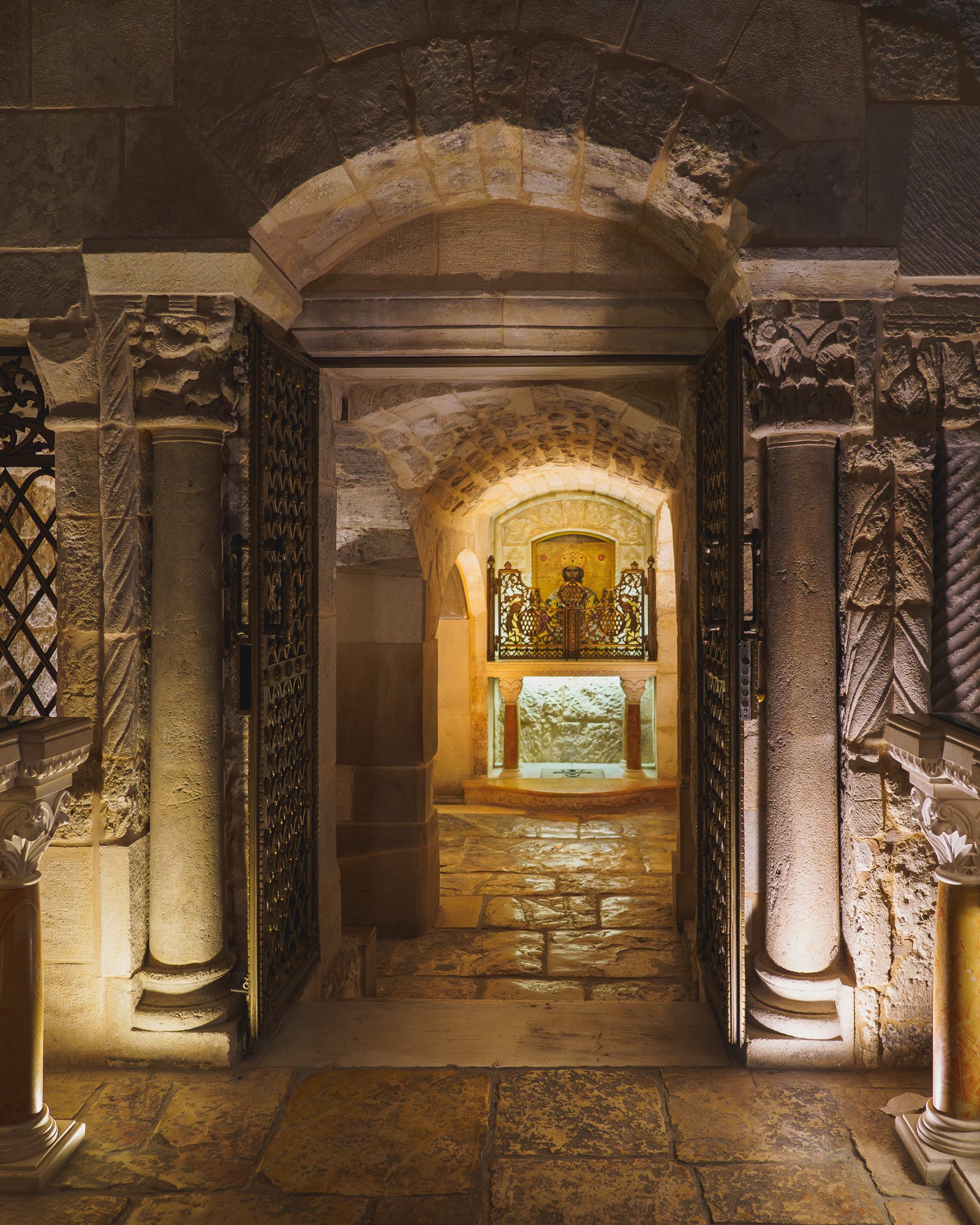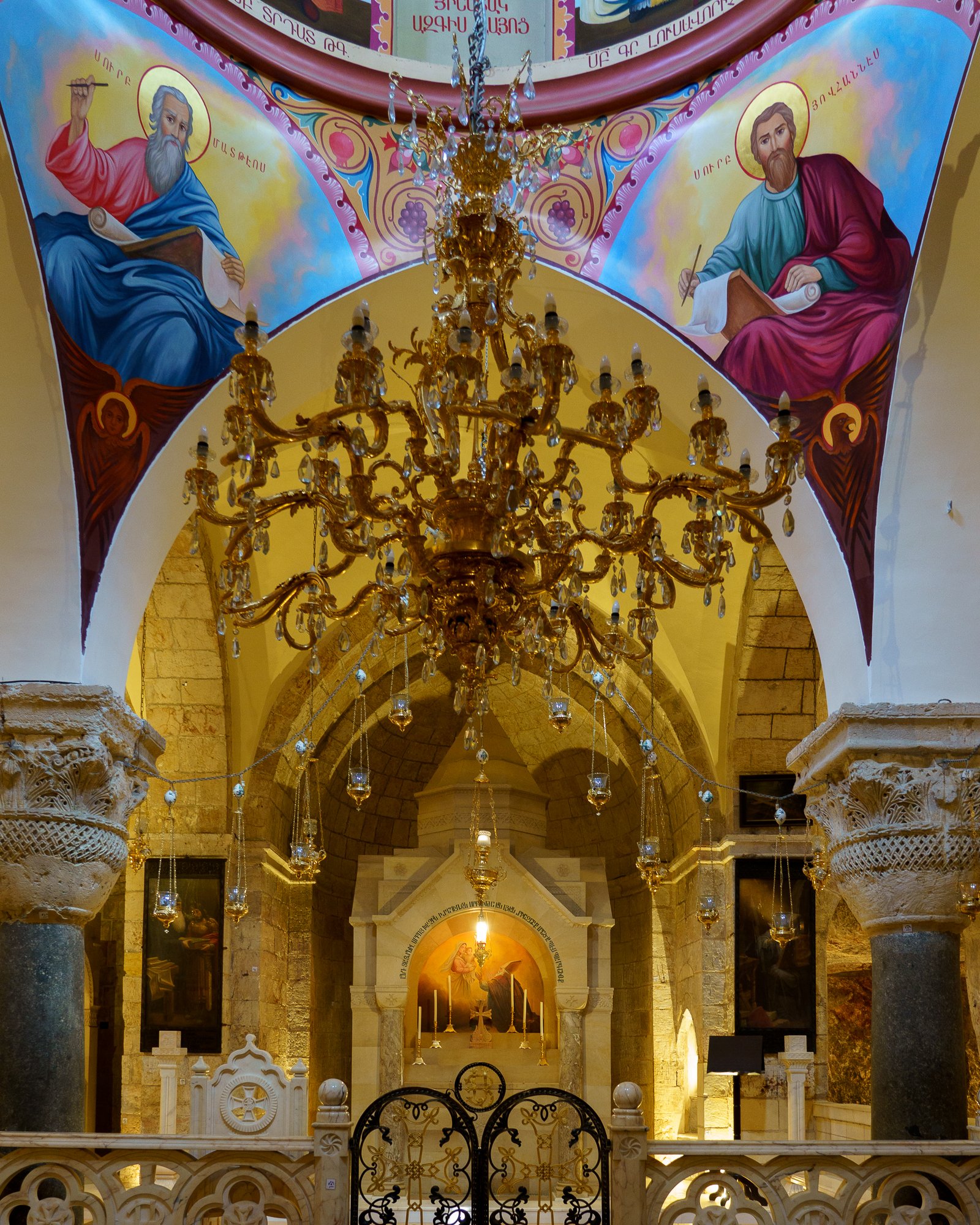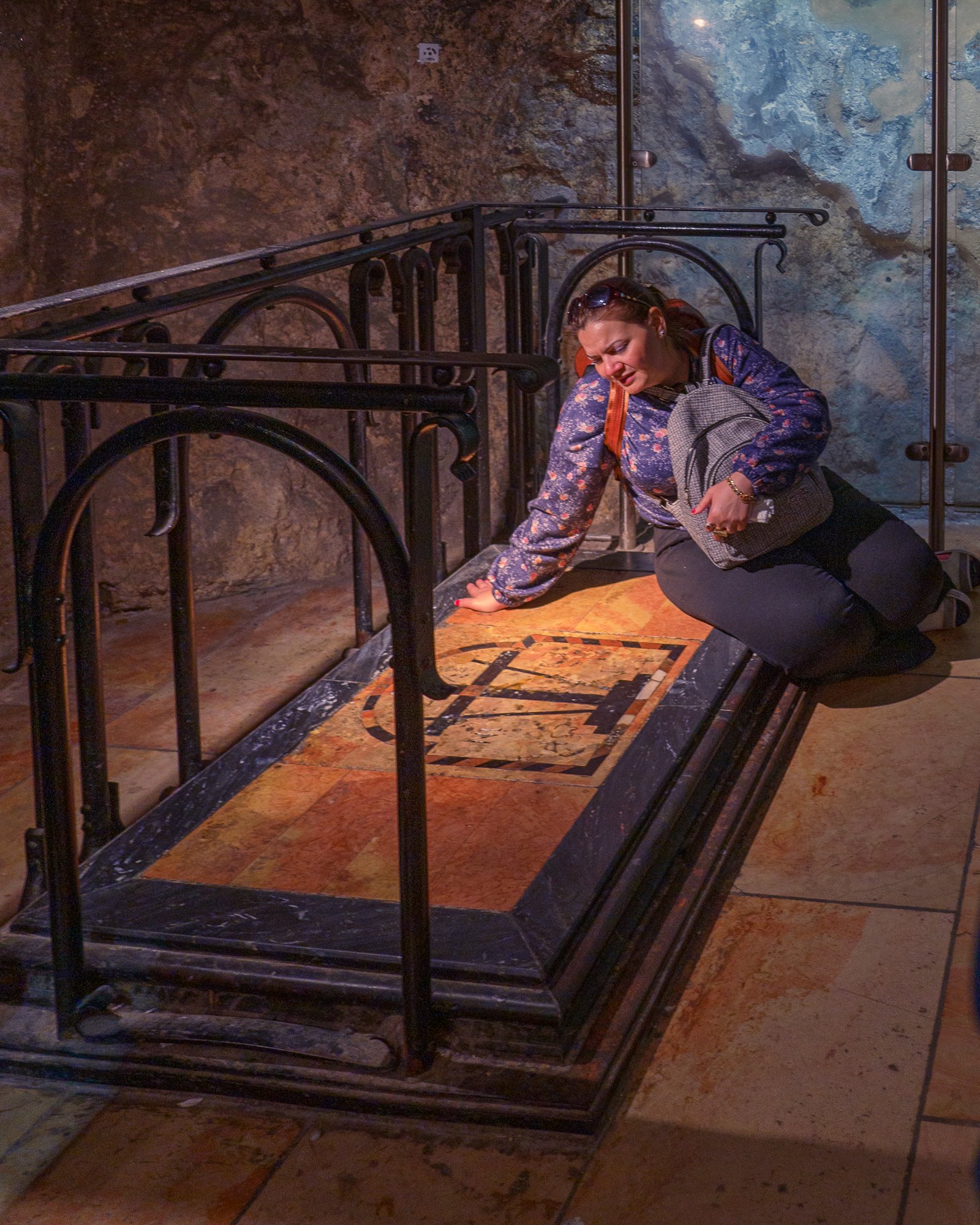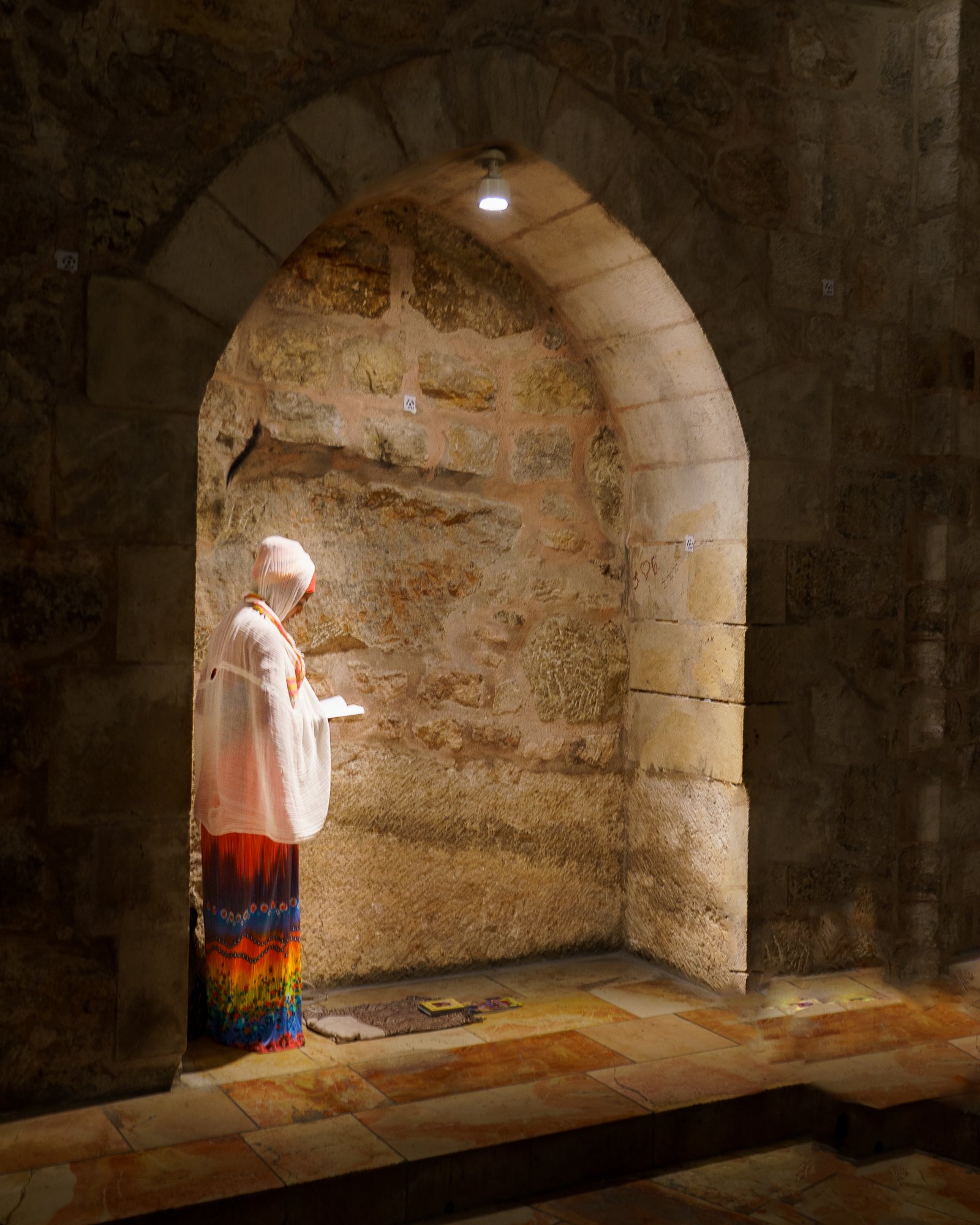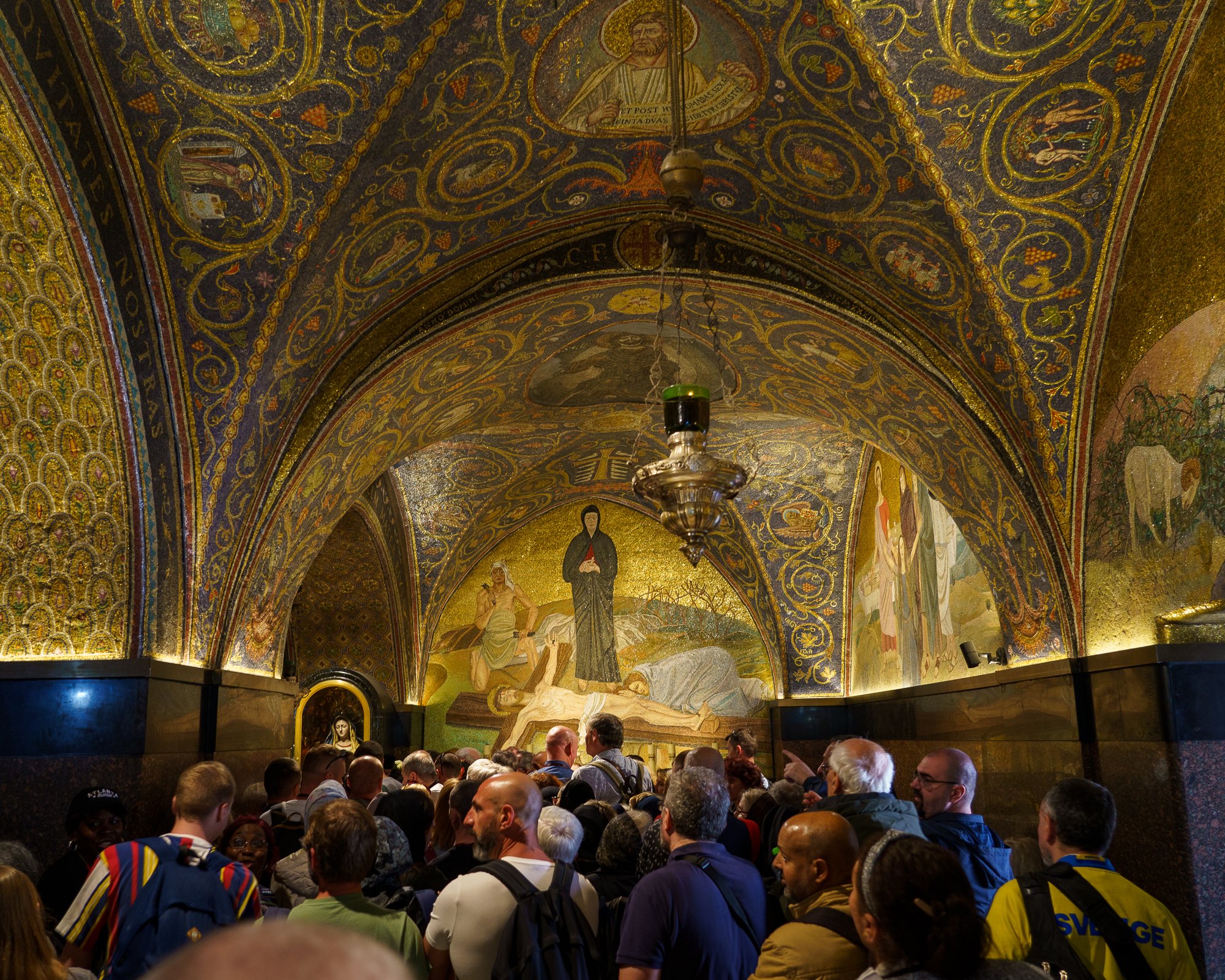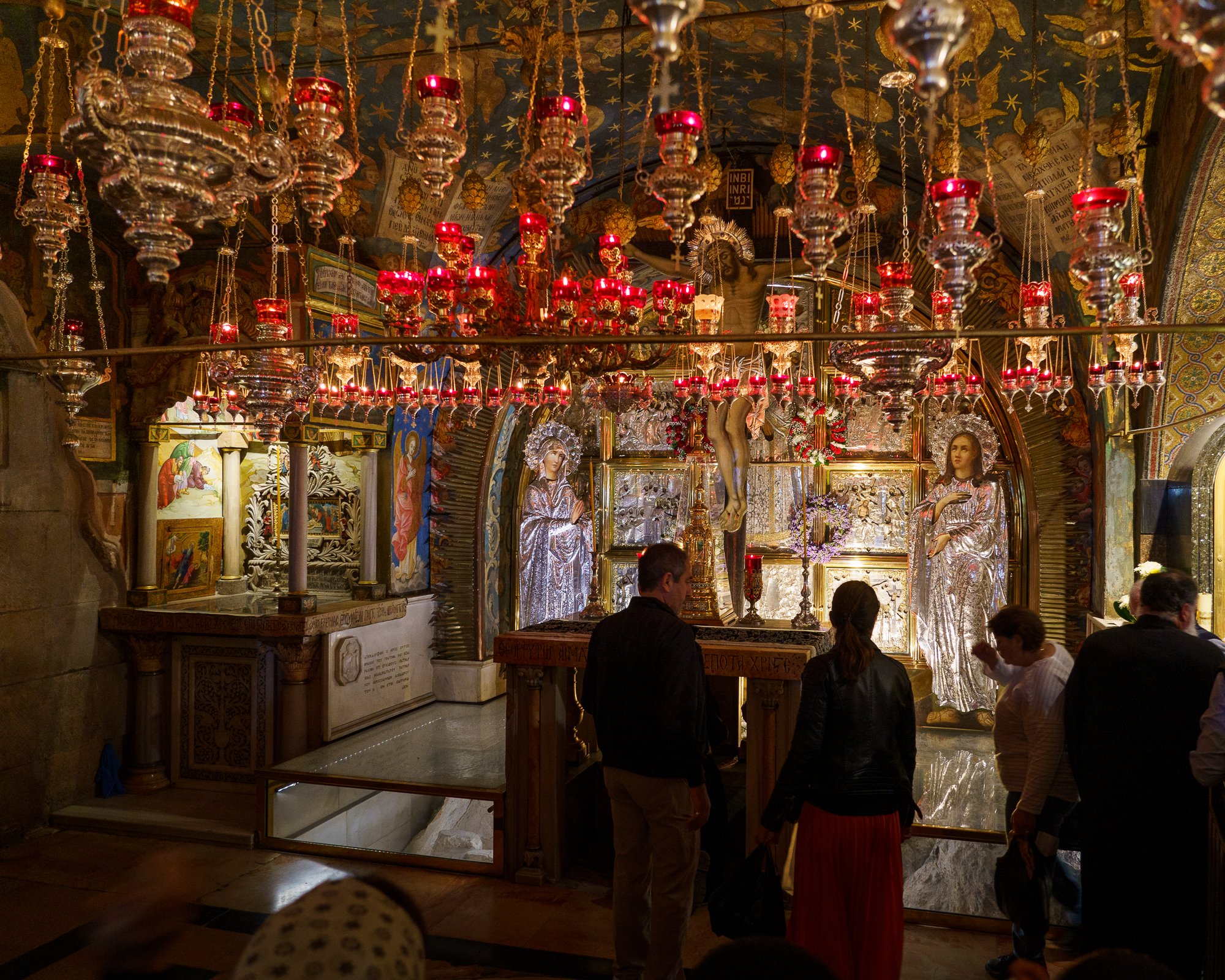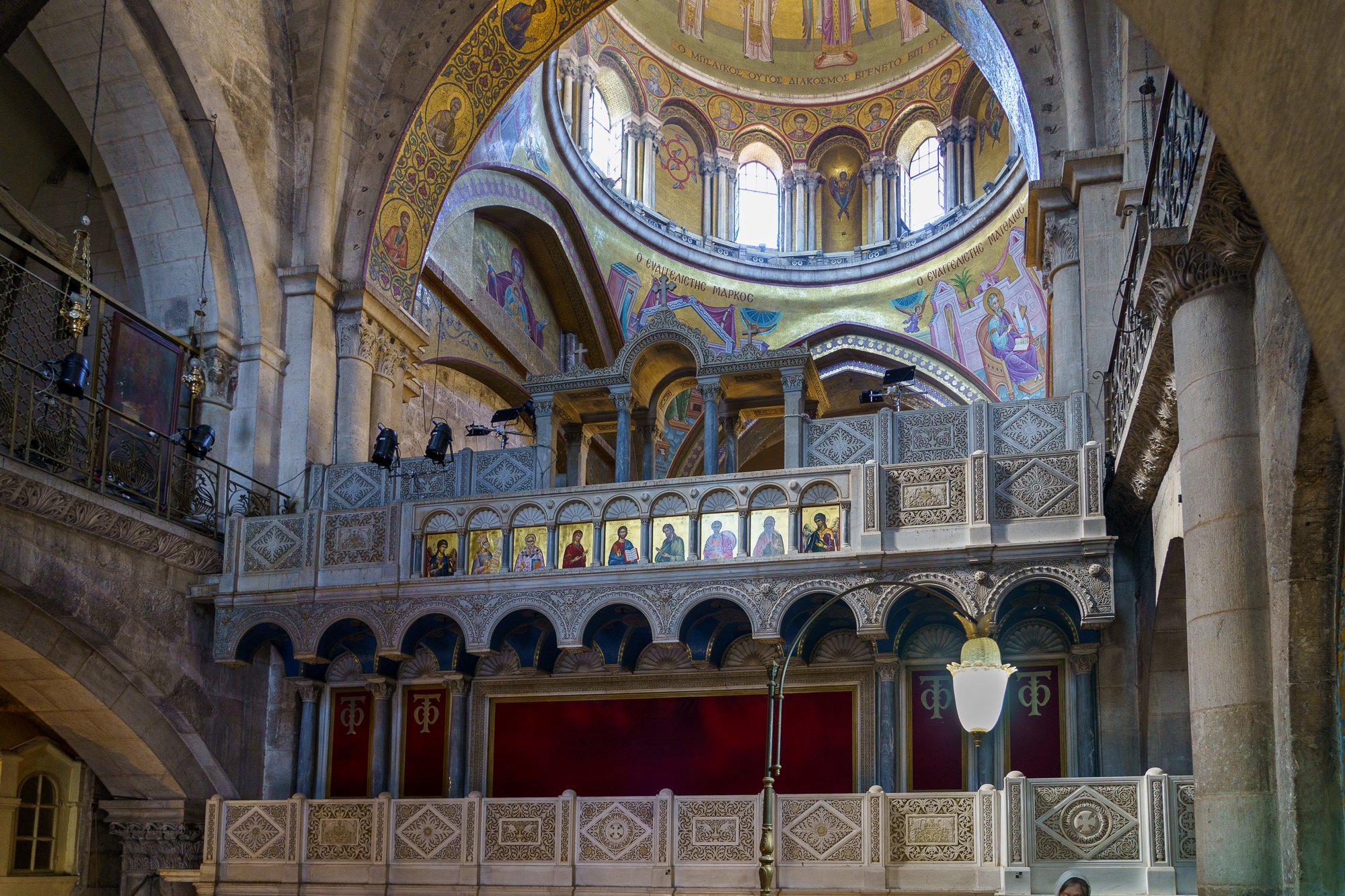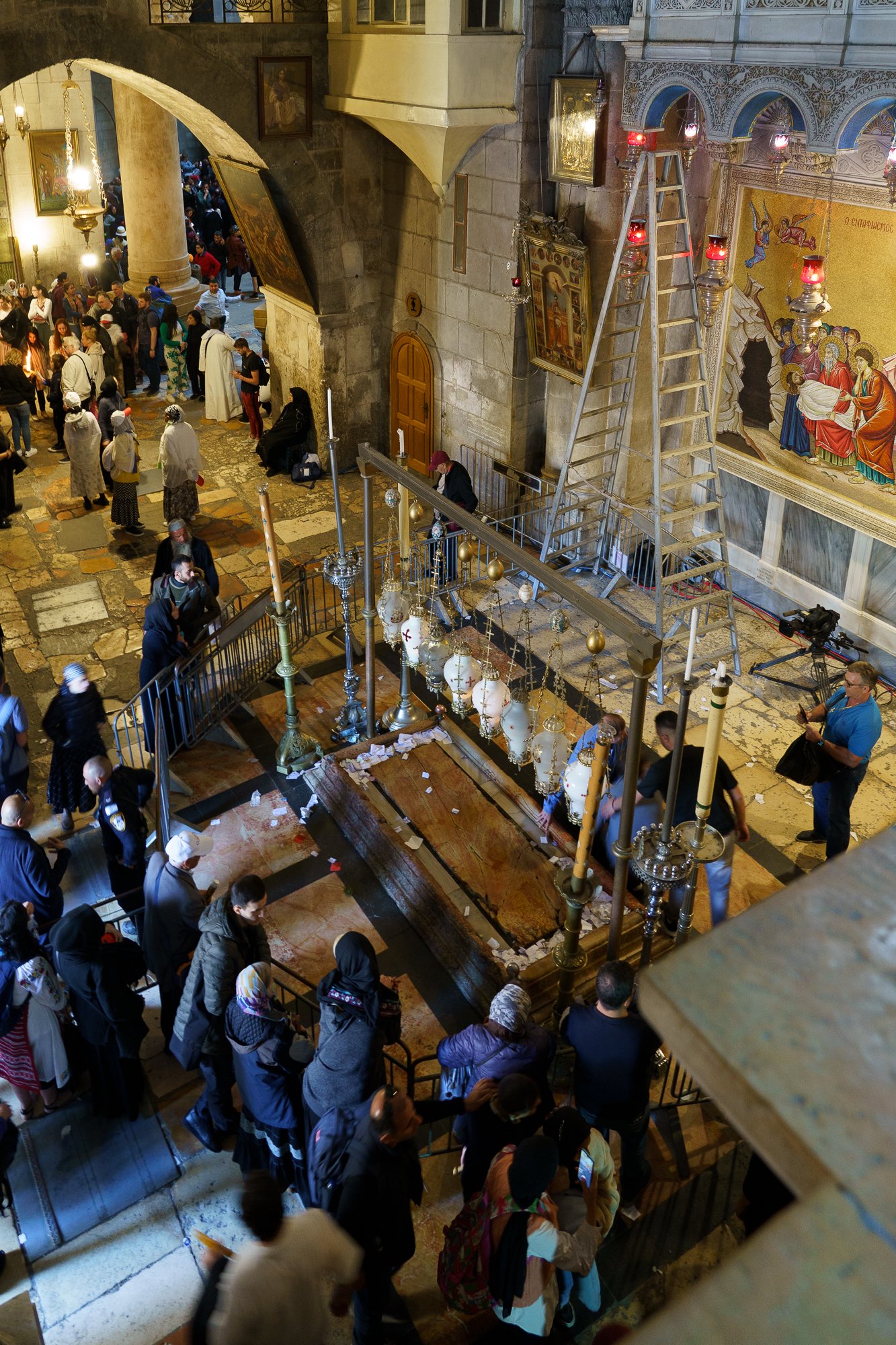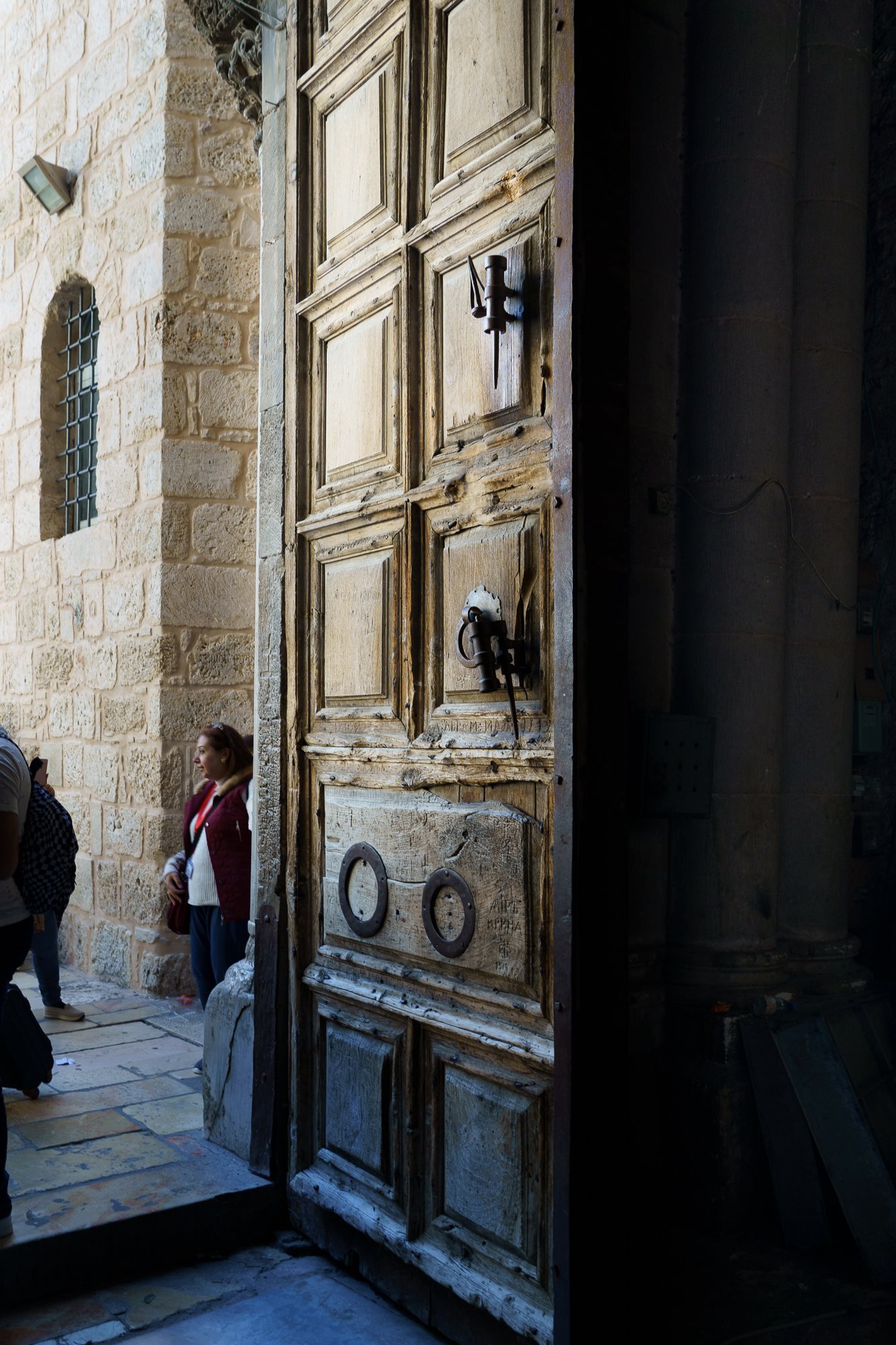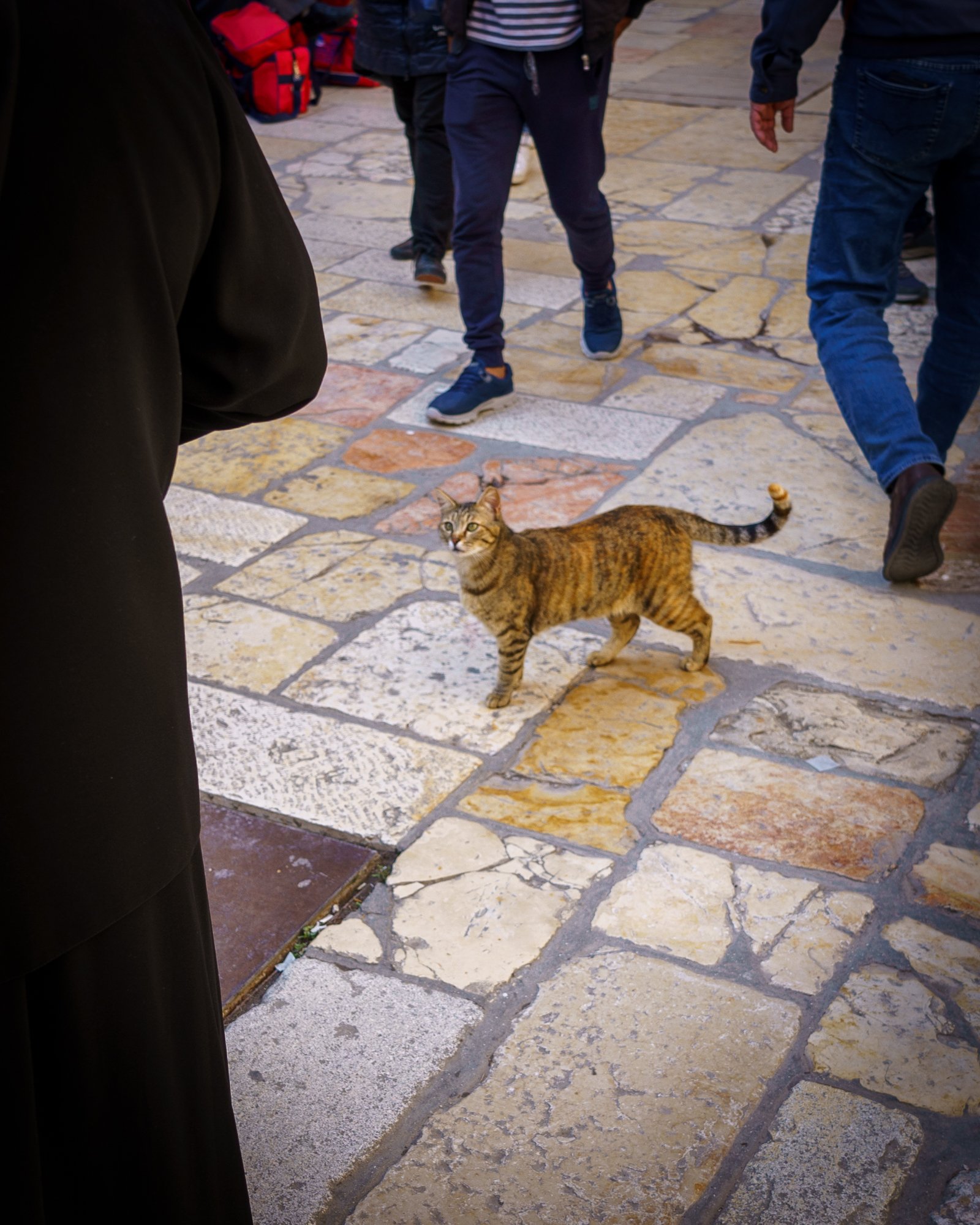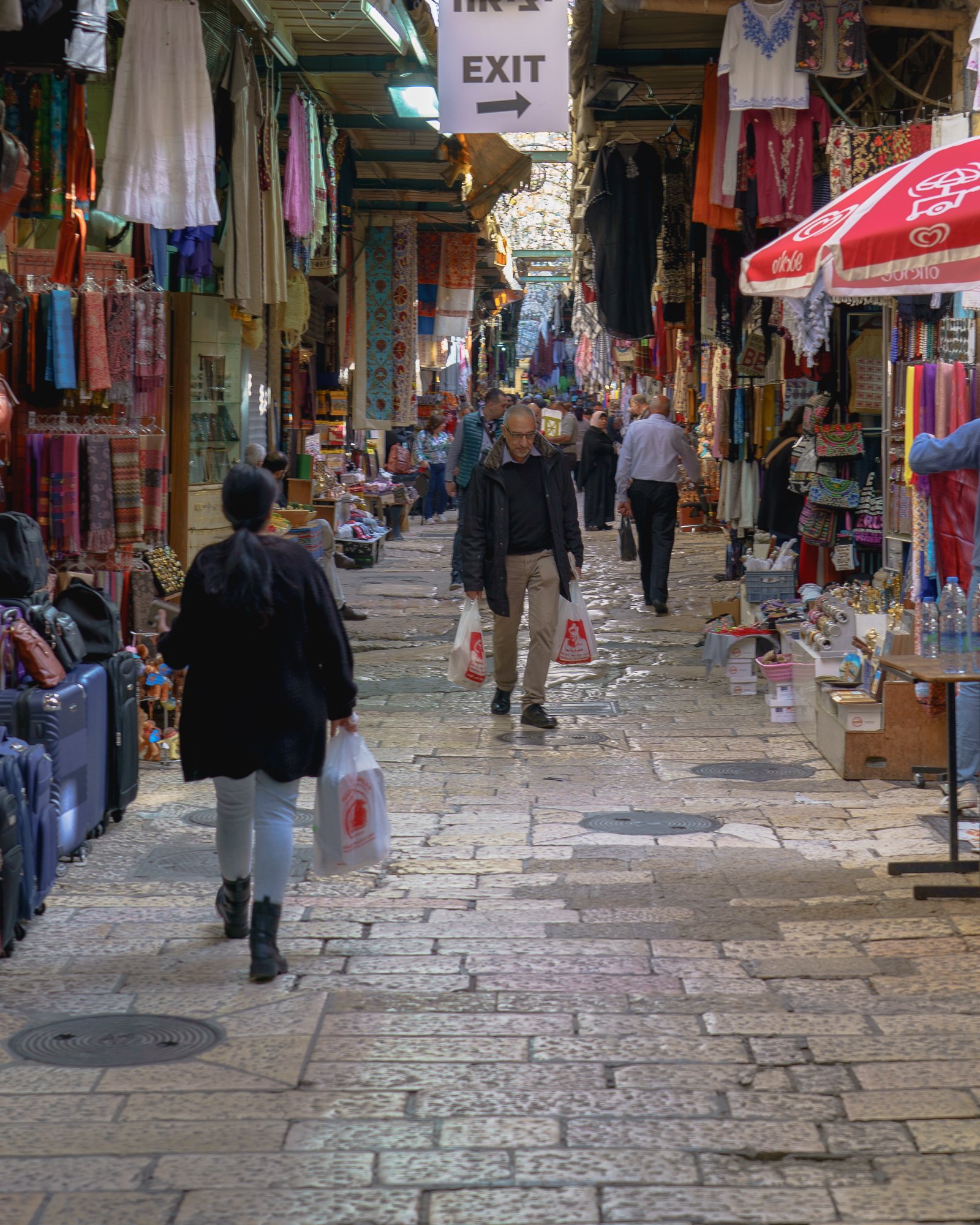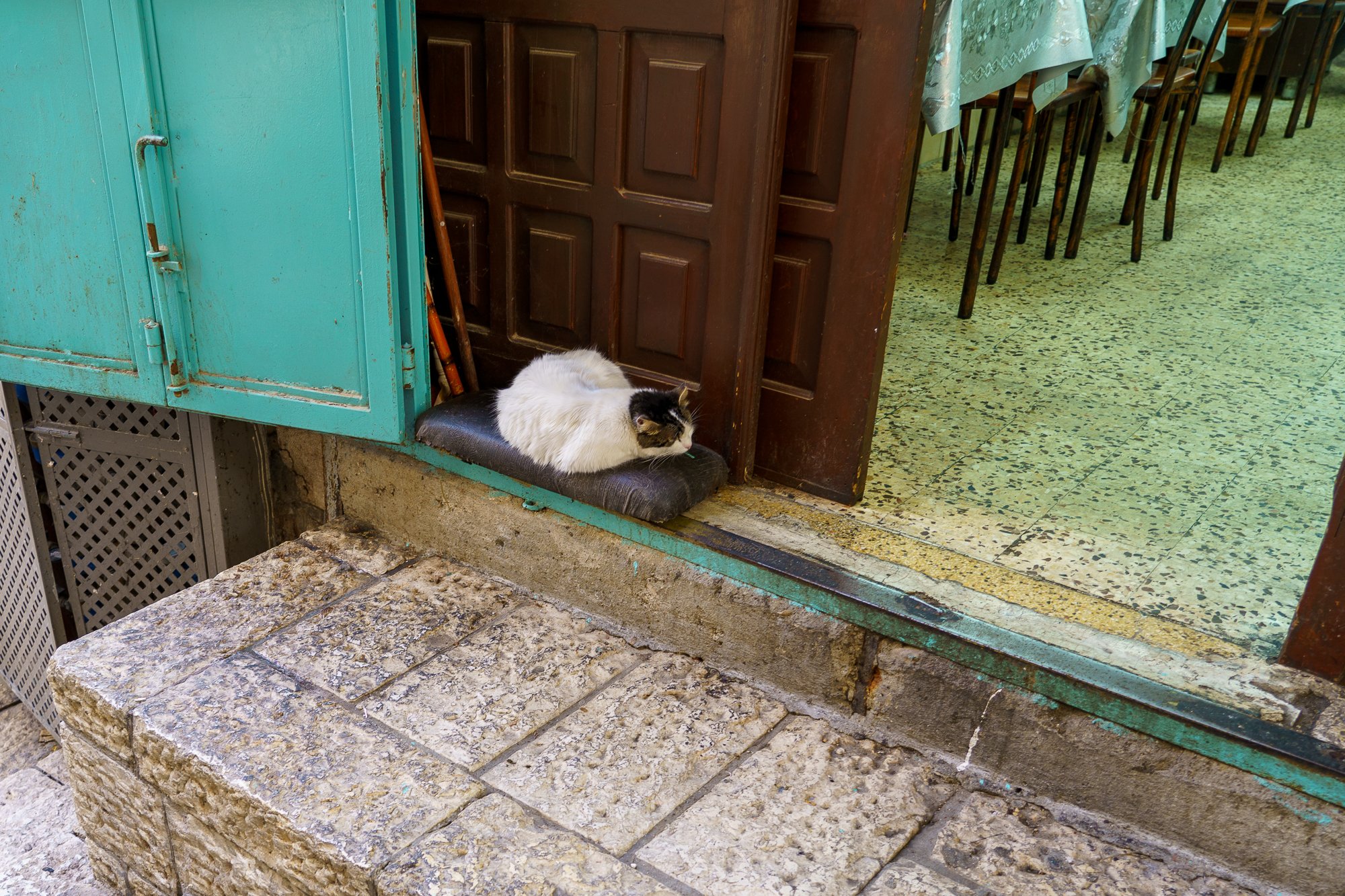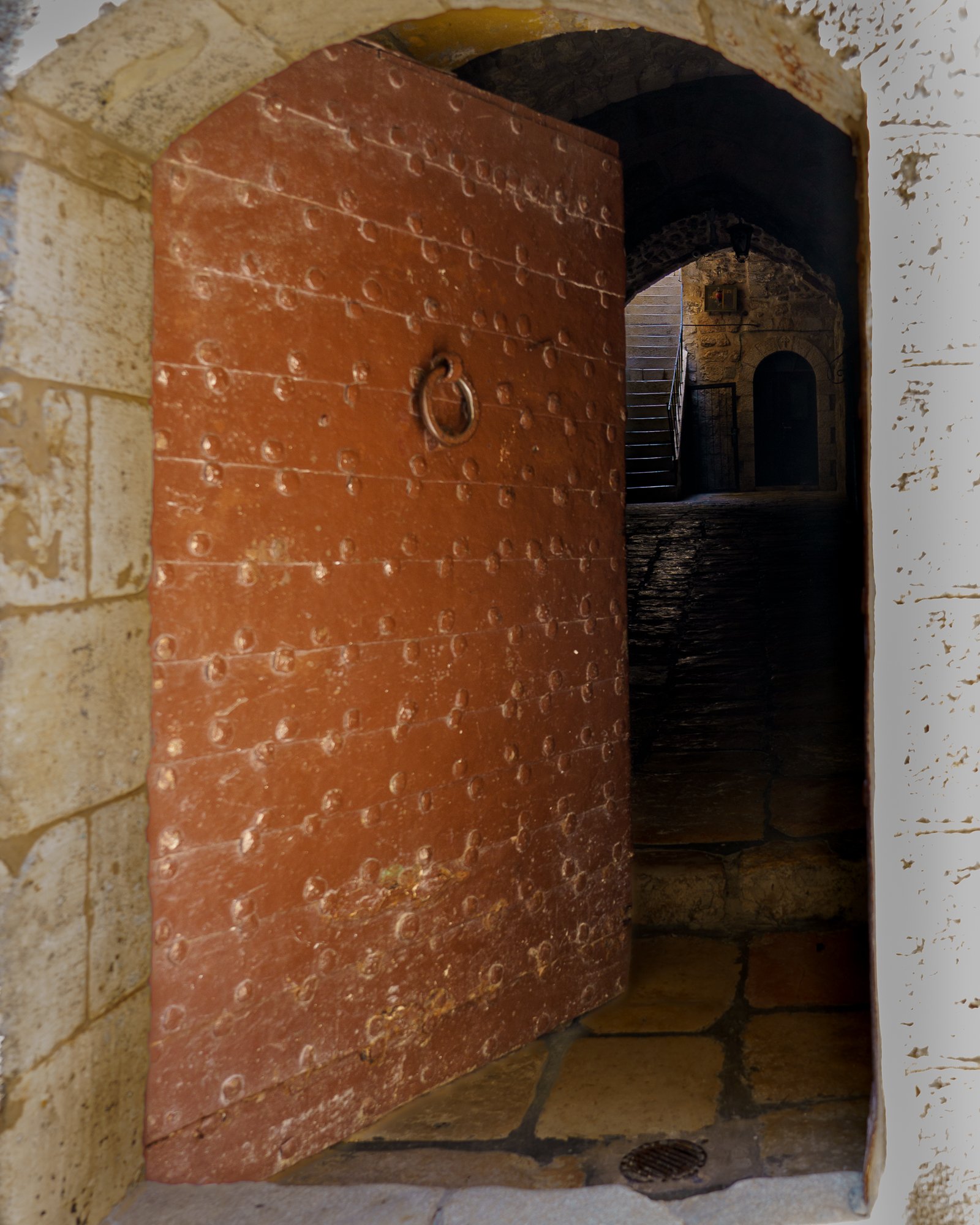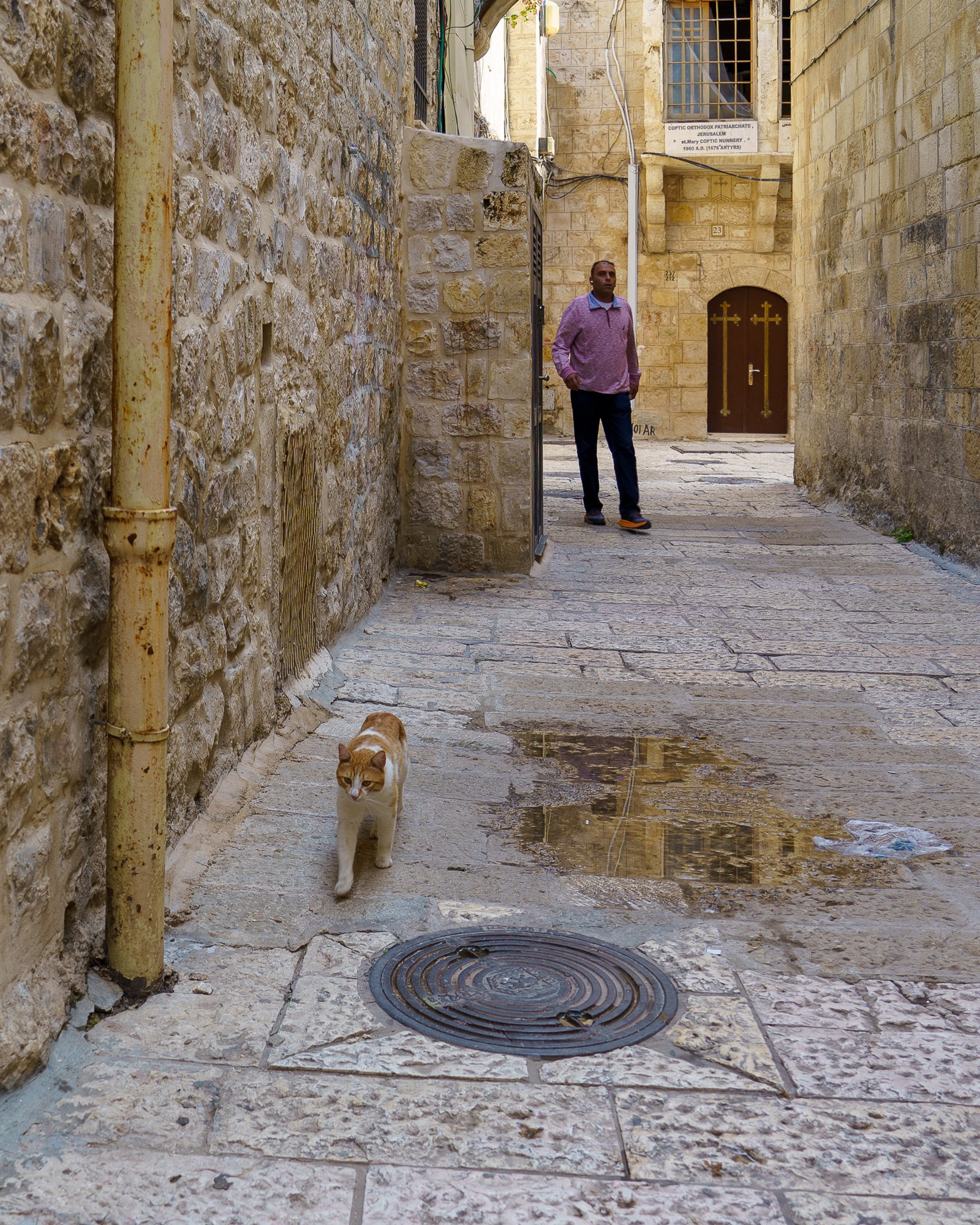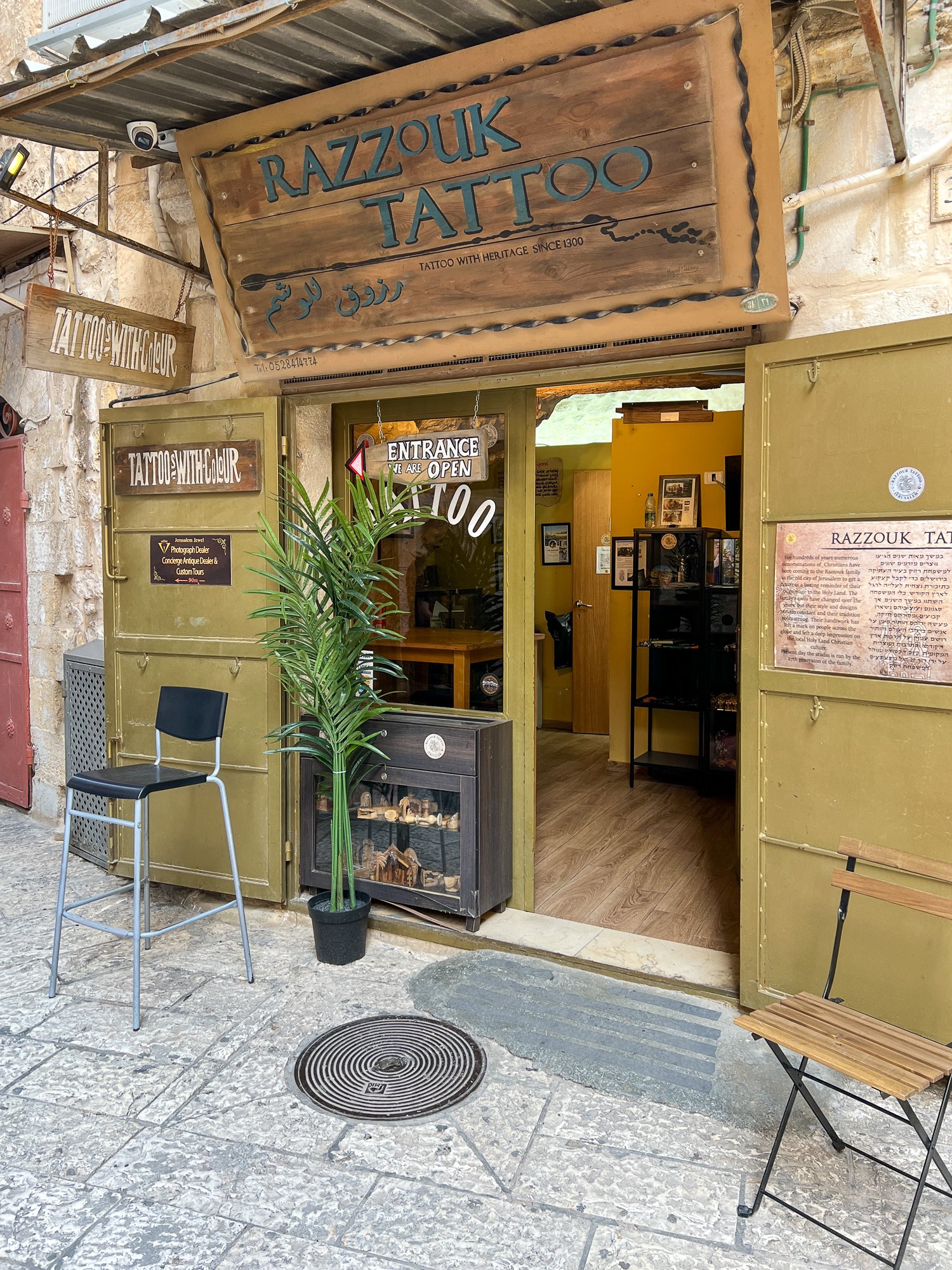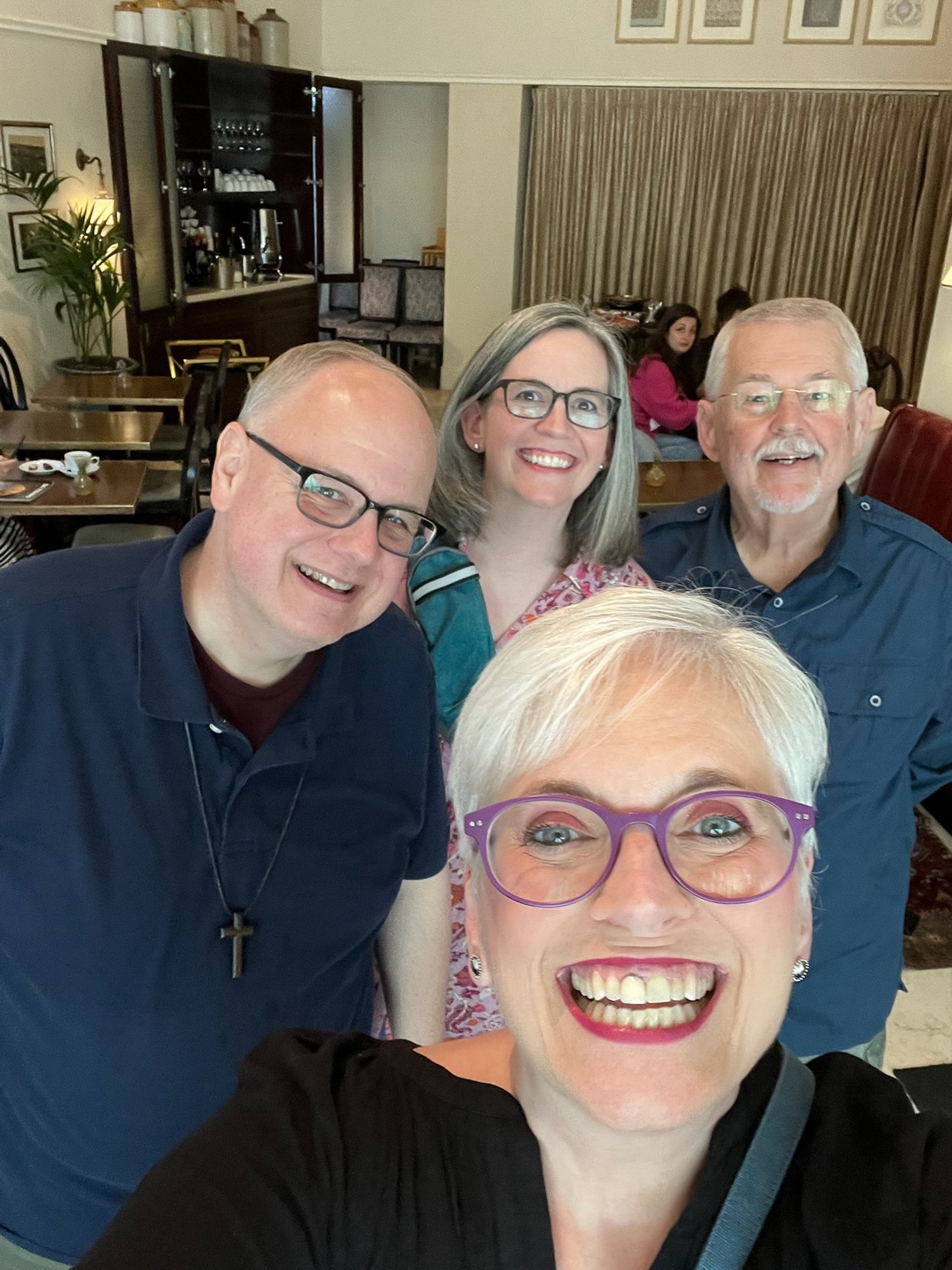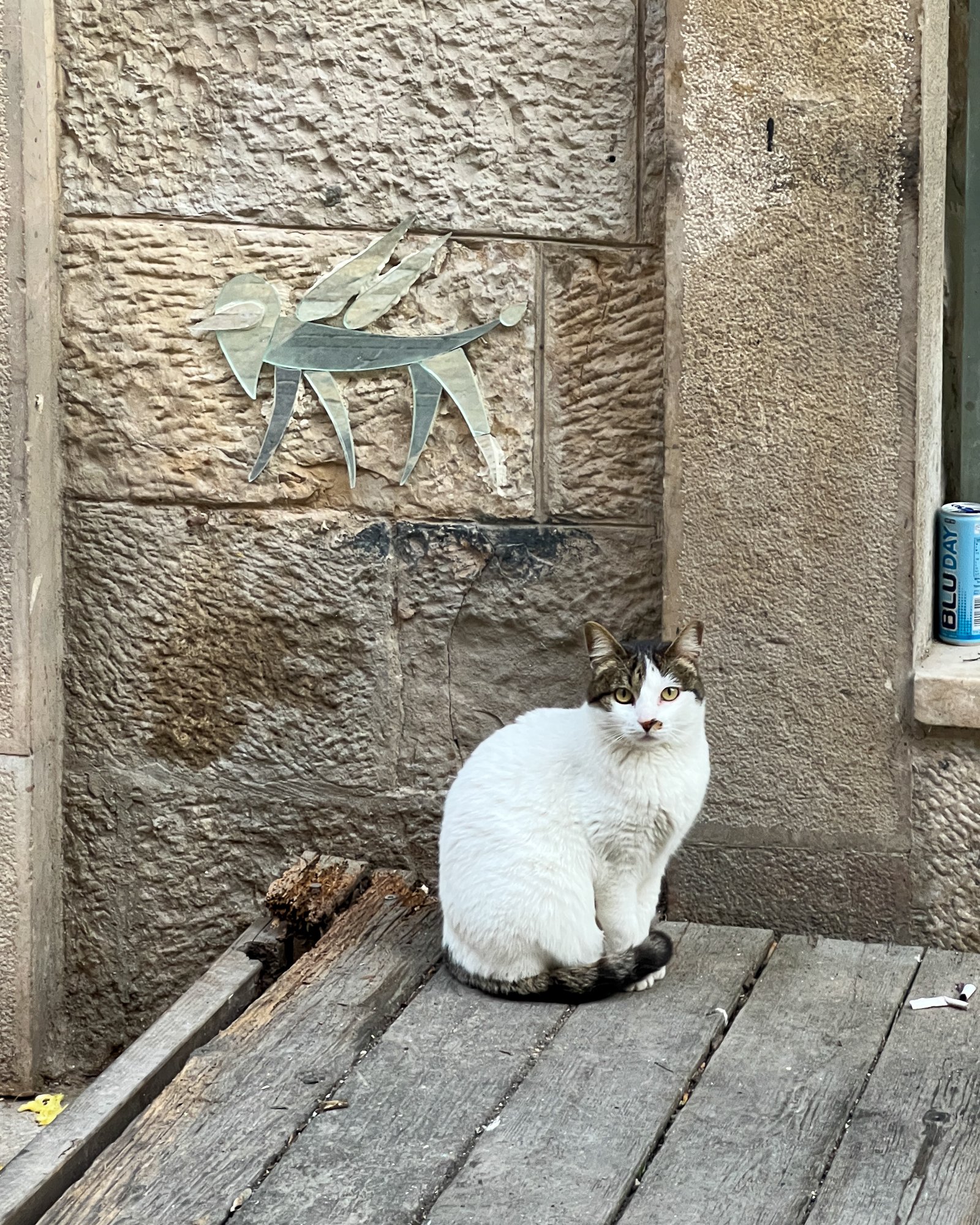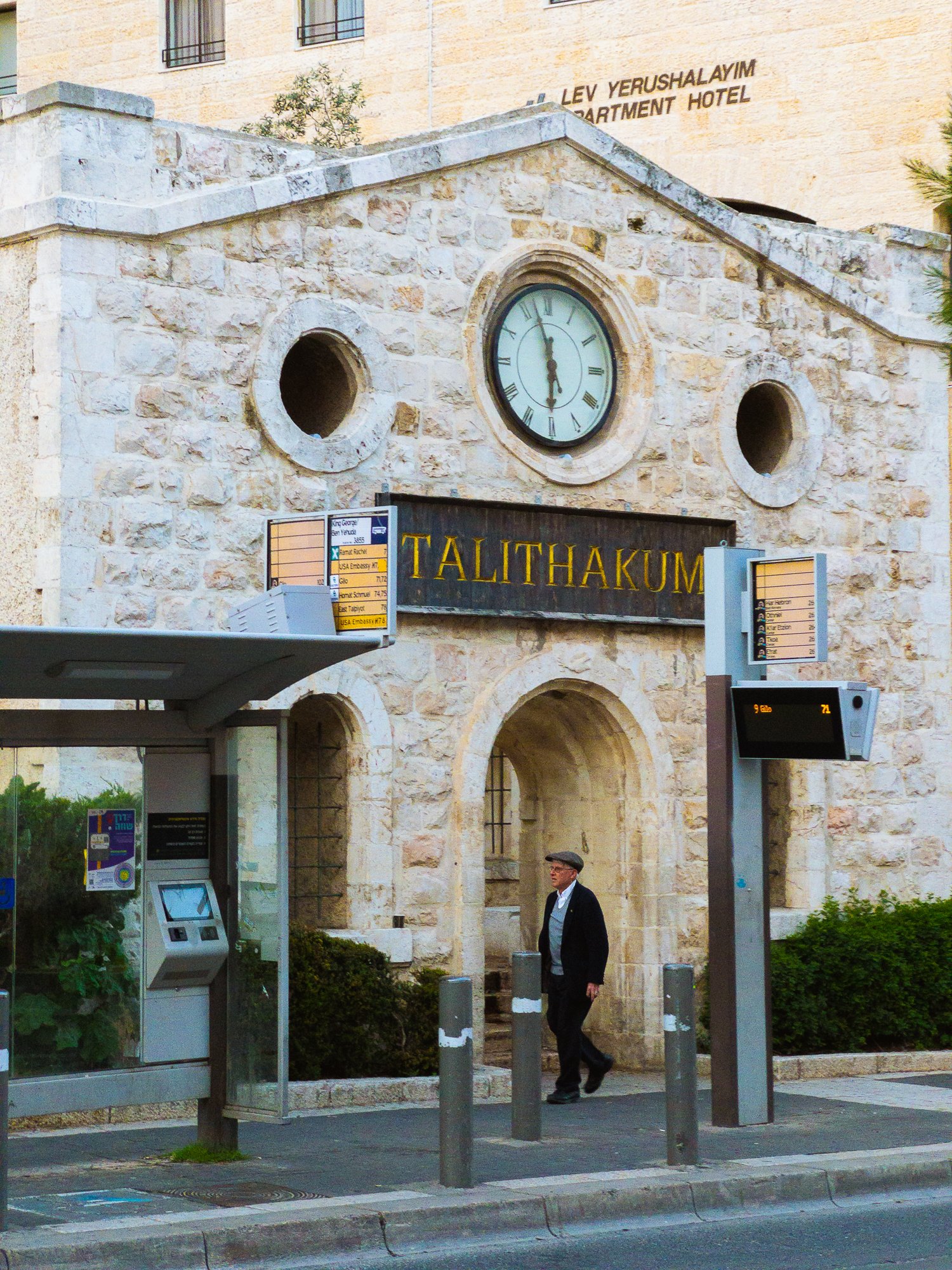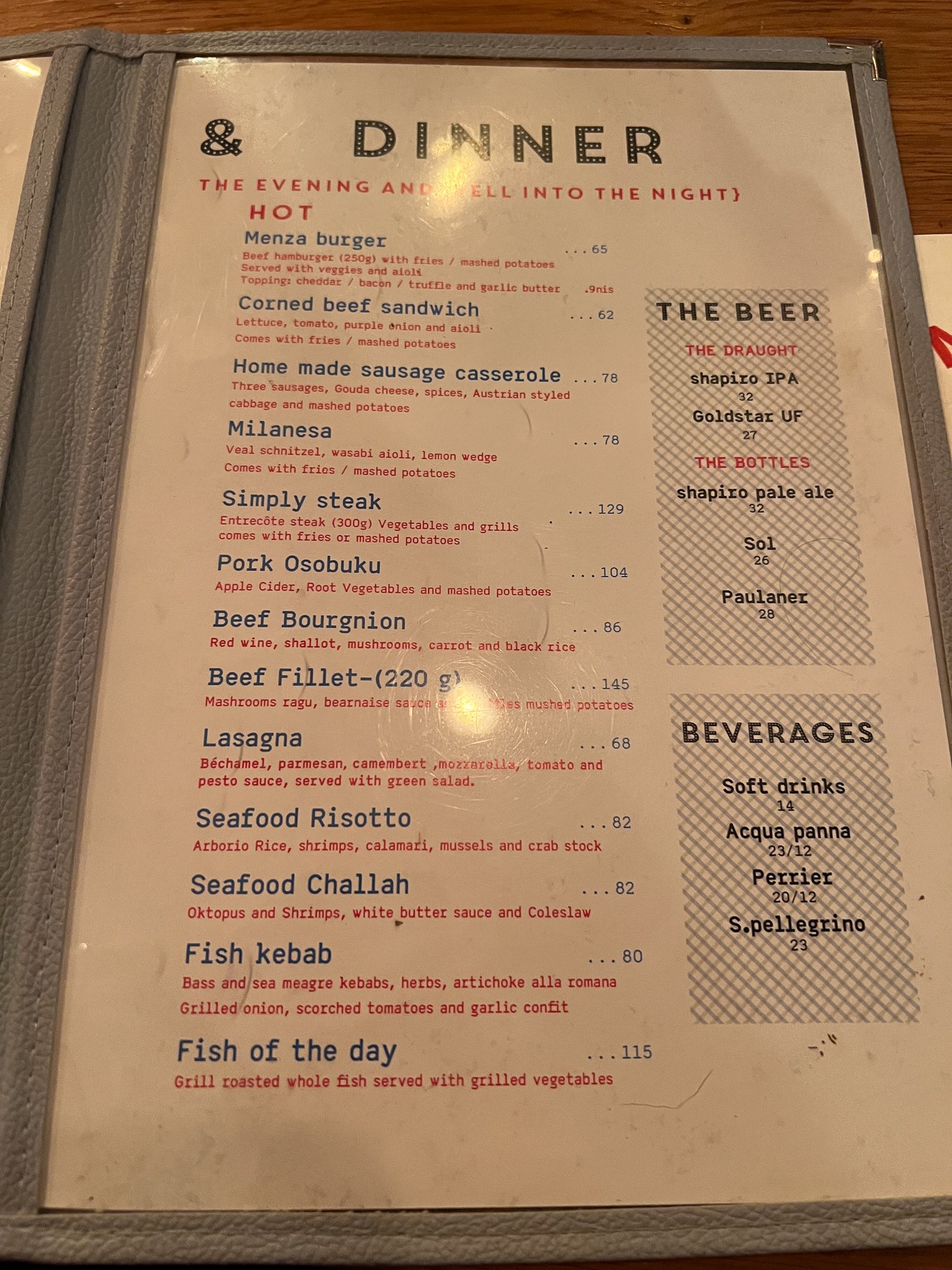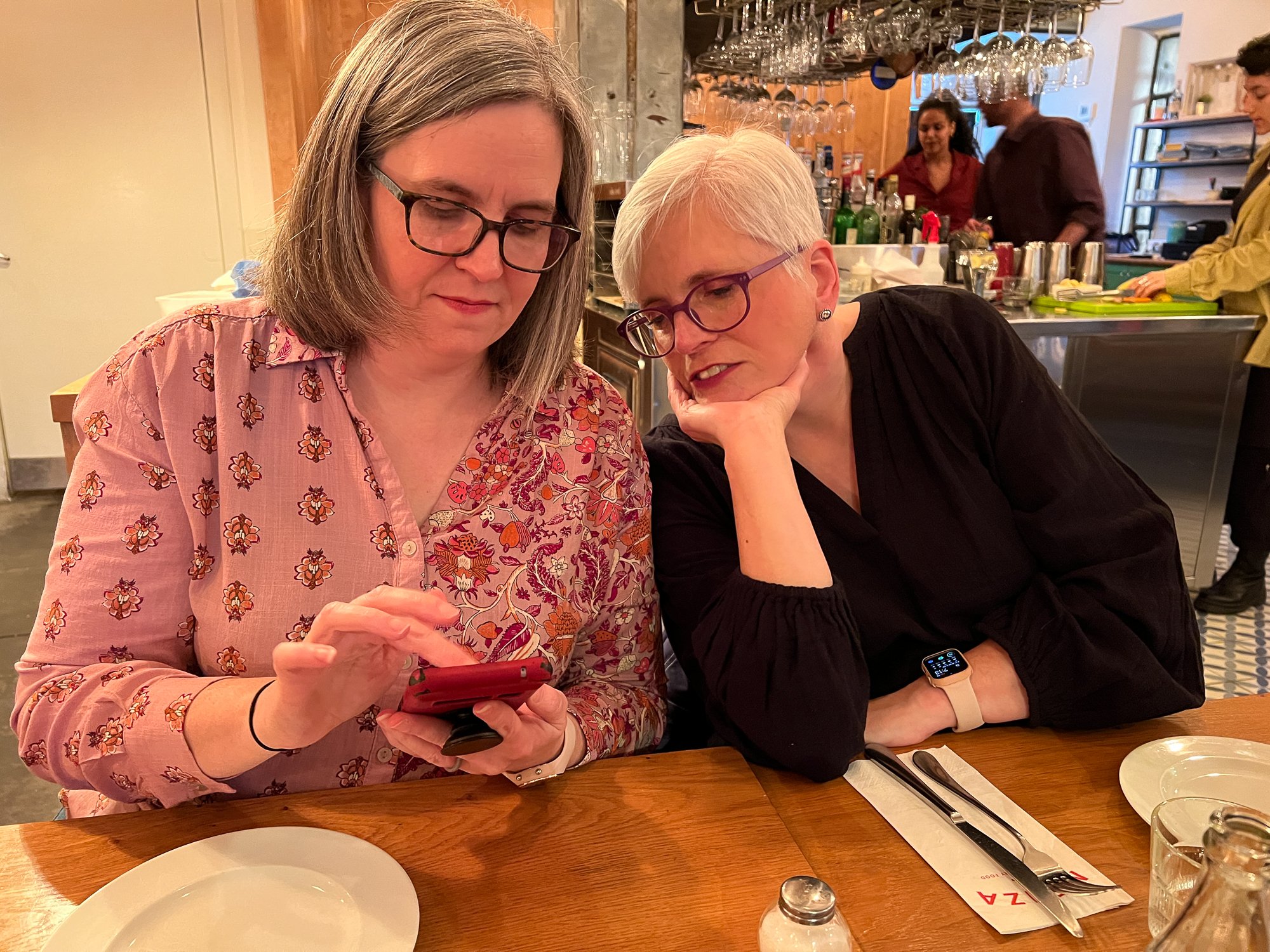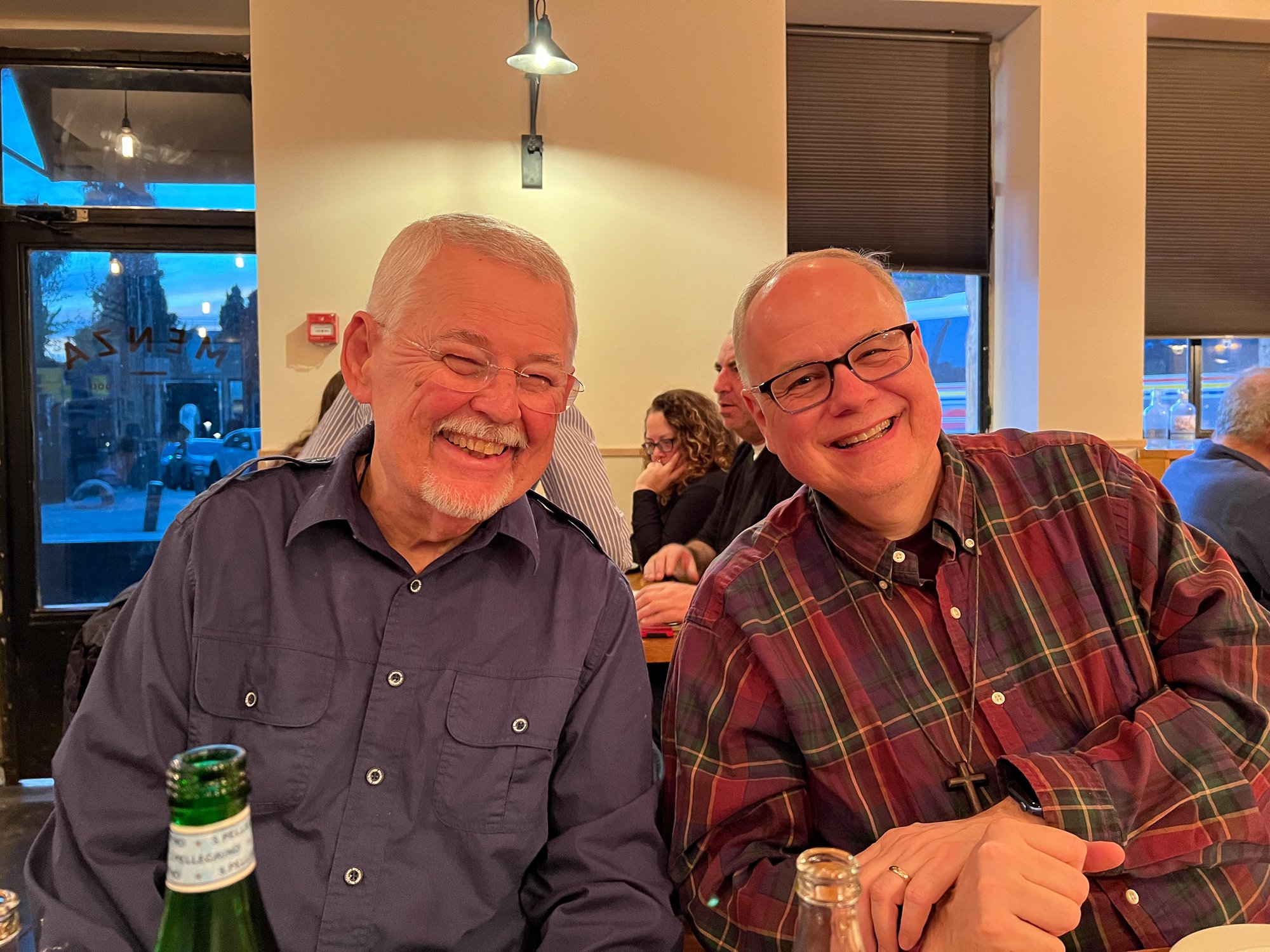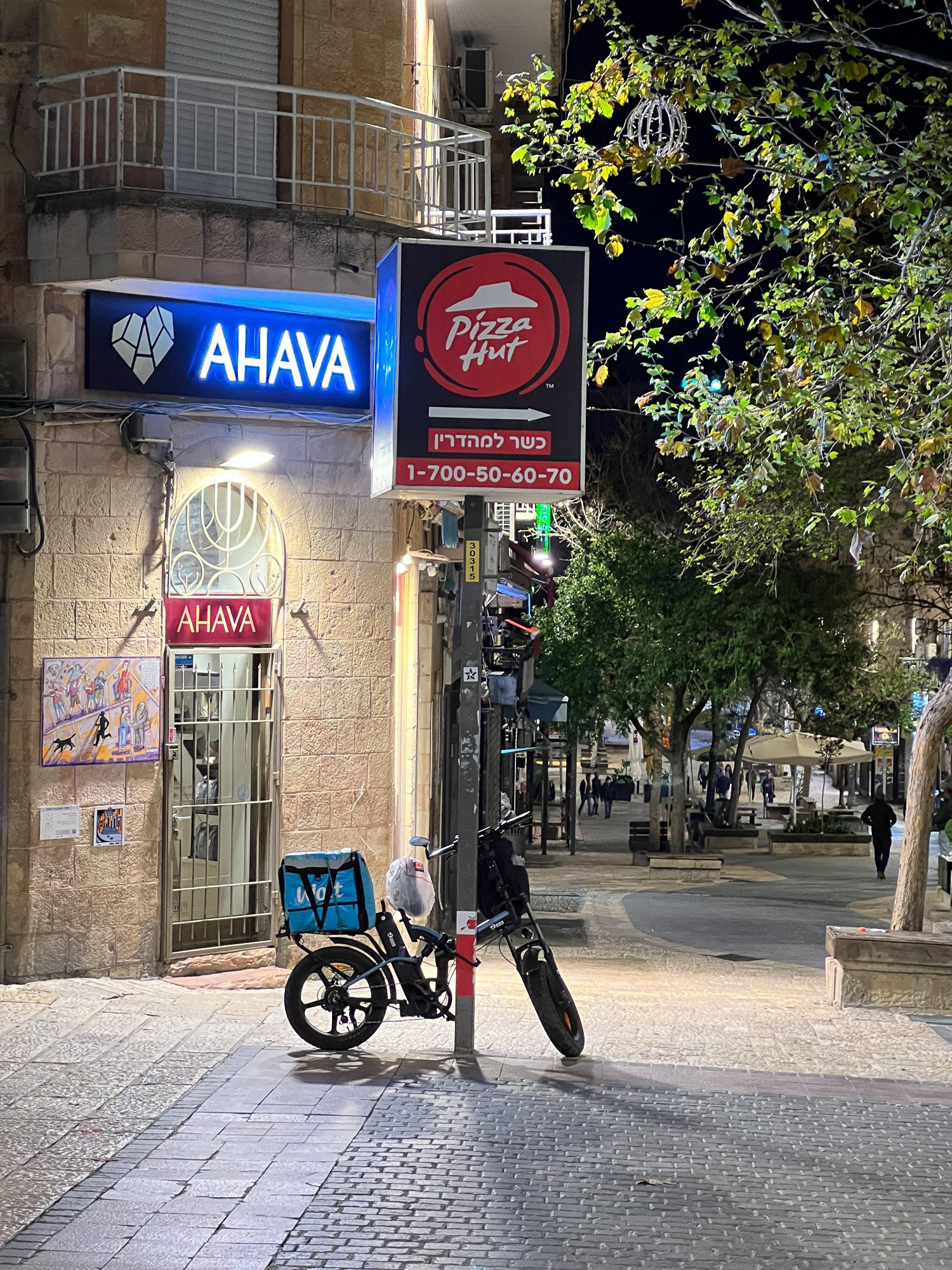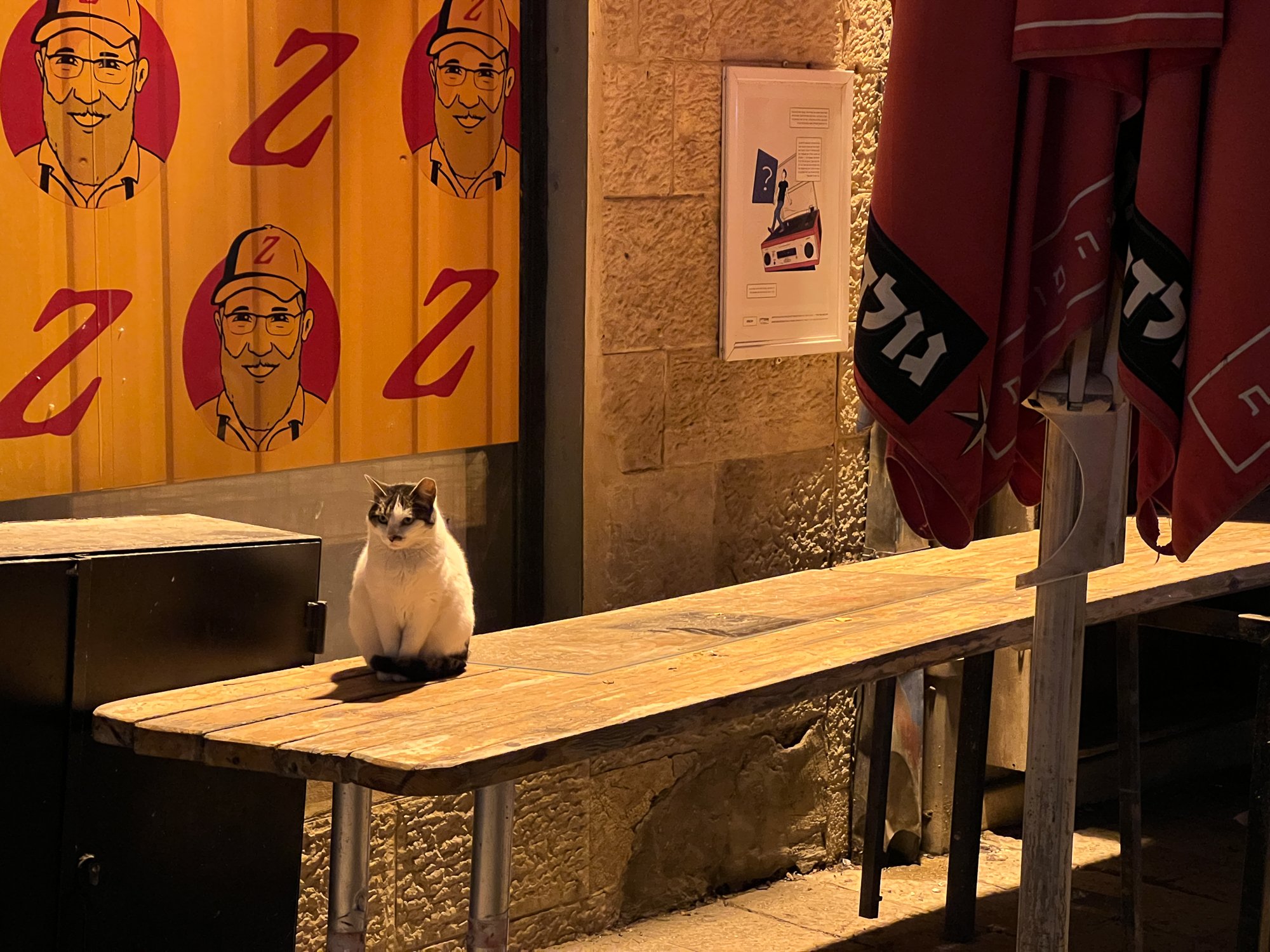Getting Oriented
Arthur Hotel has a pretty generous breakfast spread, which is where we learned that breakfast in the Middle East is cheese, labneh, cucumbers, tuna fish, various tinned fishes, hummus, pita, olives, dates, etc. No bacon, sausage, or ham for very obvious reasons! Shakshuka is another breakfast dish all parties can agree on - a stew of tomatoes and spices with poached eggs, which is popular across North Africa and the Middle East. There was always some thick yogurt, grains, and fruits for us westerners, and hard cooked eggs everywhere.
I suspect peace in the Middle East could almost be achievable around the food table, while still leaving room for each cultural group’s favorites. It also made me wonder about Jesus’ breakfast? The Gospels indicate fish after the Resurrection. I’m sure dates, olives, figs, and flatbreads were also a part of out. With roosters (sorry, Peter) there must have been hens and therefore eggs, but they’re unmentioned.
Leslie and I desperately needed our respects Sprite Zero and Coke Zero fixes, so we went shopping. We met our first of many Jerusalem cats, which are everywhere! A Judaica store caught our eye, and I really wanted this wall display of the Sh’ma in Hebrew, “Hear, O Israel, the Lord your God is One.” (Deut. 6:4). Jews recite this on Yom Kippur and it is a part of Anglican liturgy when we introduce the Summary of the Law (love God, love neighbor as self).
The clerk was tied up with a family buying souvenirs for everyone back home so we decided to come back later. We never did, and it turns out this is the work of a particular artist that is completely sold out. Oh, well. It’s not like we wouldn’t find other meaningful things to bring home! On the way back, so discovered more whimsical street art.
Leslie’s sister Loren was flying in today so Jim and I headed out to the Old City while Leslie waited for Loren’s arrival. The Old City is THE Jerusalem of Scripture. It is physically in East Jerusalem, which was Jordanian/Palestinian territory until the Six Day War in 1967 when Israel occupied East Jerusalem and the West Bank. It is still occupied territory but the average visitor will not notice that. Israel is fully in charge. However, non-Jewish citizens of East Jerusalem (including the Old City) are not Israeli citizens and are effectively stateless. They have no vote or say in national affairs, though they are able to participate in municipal governance.
The Jerusalem Municipal Complex
An East Jerusalem residence card is highly prized because of the freedom and status it gives non-Israeli residents compared to Palestinians in the West Bank. Movement between regions is controlled and what identity card you have determines the your freedom of movement and the level of inspections at internal border crossings. We met a Palestinian man whose home is in Ayda Refugee Camp outside Bethlehem in the occupied West Bank). His wife is a resident of East Jerusalem. He cannot spend the night with her in East Jerusalem, but must be home by 10 pm. She cannot move in with him because she will surrender her East Jerusalem residency and privileges if she does. Their children live with her for the sake of better opportunities. This is just one aspect of the everyday reality non-Israeli residents of the land experience. The experience is not dissimilar to Native American reservations or the old Bantustans in South Africa during the Apartheid Era.
It is impossible to visit Israel/Palestine as a pilgrim and not be confronted by the modern reality. Being a pilgrim also means encountering God in ways that help us grow in our faith today, and our lived faith is the modern world with its modern realities. A trip to the Holy Land is as much about encountering the Jesus of Scripture is it is about the wounds in Christ’s body today. This is why Jesus stretched his arms on the Cross - to heal the broken world. The Resurrection is the first fruits of that healing that is for all of us, and so, as Pilgrims, we make our way straight to the site of the Empty Tomb.
The Old City is a walled city to this day, with impressive gates on every side for entry. The current walls date the 16th century. In Jesus’s day, much of the current city laid outside the boundary walls. Tens of thousands of Christians would gather for the Holy Fire ceremony so the police were setting up holding pens for them.
The Arab inscription on the Jaffa Gate reads, “There is no God but Allah, and Abraham is his closest friend,” reflecting a time of great respect between Islam and Judaism.
Resurrection and New Beginnings
It’s said the pilgrims visit the Holy Sepulchre twice - both at arriving in Jerusalem and upon leaving. We are people of the Resurrection so that is the first place of veneration, and then as we follow the story of Jesus, we meet there again experiencing our own renewal, rebirth.
There is so much to say about the Holy Sepulchre! First, it goes by two names. In the West, we call it the Church of the Holy Sepulchre, the place of death and burial. In the East, it is called the Church of the Anastasia, the Church of the Resurrection. I find the different emphases fascinating.
The gray domes of the Church of the Holy Sepulchre and the gold dome of the Dome of the Rock are two of the three holy sites that define life in the Old City of Jerusalem. The Western Wall, of course, is the third.
This would be a good time to note that archaeologically, we are pretty certain that the the sites we visited are the sites where the events commemorated actually happened. If we cannot identify the exact spot, it is likely within a matter of feet. There are a couple of instances where archeology has shown events almost certainly did not happen in the location where they are remembered. Nevertheless, they have been the site of devotion for so long, that we continue to remember those events in those locations. The biggest example of this is the Way of the Cross. The route that commemorates the first half of the Stations is probably not the route that was taken, but it is the route that pilgrims have followed for over a thousand years which has power in and of itself. The second half of the stations are most likely accurately located, so you still end up in the same place.
The Holy Sepulchre is not really a church but a collection of shrines in one building. The original church was built in the Fourth Century and then was expanded, destroyed, rebuilt, and remodeled over the centuries as different powers controlled Jerusalem. The basic eras of control since the time of Christ are Roman/Byzantine, Muslim Caliphates, Crusader period, Mamluks, Ottoman Turks, British Mandate, Jordan, and Israel.
The current church is overseen by three major Christian groups and three minor groups: the Greek Orthodox, the Roman Catholics, the Armenian Orthodox, and then to a lesser extent, the Coptic Orthodox, Syrian Orthodox, and Ethiopian Orthodox. They each have designated areas for access control, financial responsibility, and liturgical privileges. This is called the Status Quo, which was imposed by the Ottoman emperor in the 18th century when the various Christian groups could not agree. The Ottoman sultan basically said, “The way things are now, today, is the way they always will be.” Nobody gives up anything they have, nobody gets anything they do not have. That Status Quo continues to have the force of law today.
Occasionally disputes do erupt. An Ethiopian monk and Coptic (Egyptian) monk got into a fist fight when an Ethiopian monk moved his Ethiopian Chair underneath a tree in a Coptic portion of the roof patio for shade. That was seen as an incursion and illegal grab of territory. Pilgrimage cannot escape modern realities!
The Status Quo also gave two Muslim families control of the keys to the Church to guarantee fair access. One family holds the keys. The other family has the right to lock and unlock the doors. It was deemed too risky to give one family complete control. Each morning, at Five AM, representatives of both families come. One presents the key. The other unlocks the door.
We arrived on Orthodox Good Friday, which was also the final Friday of Ramadan. Can we say crowds?! We visited the Christian Information Center to get our bearings. They have a roof top terrace and cafe with magnificent views. We could see the whole city below us, including the Haram el-Sharif where the Dome of the Rock and the Al Aqsa Mosque are. Tens of thousands of Muslims were participating in Noonday prayers.
We made the mistake of timing our from the rooftop with the end of the Noonday prayers. As thousands of Muslims headed out to the Jaffa Gate, we were headed in the opposite direction to the Holy Sepulchre! Shopkeepers kept begging us to step in and “wait” for the crowds to die down. There is a reason tour guides tell you to avoid entering the Old City through the Jaffa Gate - it’s where all the tourist shops are. The Damascus Gate and New Gate, we would discover, are much easier!
The Holy Sepulchre was open to the public since the Good Friday services took place early in the morning. Crowds were starting to gather and stake out spots for “The Holy Fire” ceremony the next day. This is part of the Easter rituals that is like the blessing of the Paschal Candle at our Easter Vigil. The Orthodox Patriarch of Jerusalem goes into the Tomb of Jesus and reapers with candles lit with fire. The fire is then passed on to everybody in the church, and outward to the thousands gathered in the courtyard and streets. It is then taken carefully to the airport and flown to major Orthodox churches around the world. The Light of Christ scatters the darkness all over the world!!
All six Christian custodians of the Holy Sepulchre expressed publicly their outrage when Israeli Police limited attendance of the Holy Fire Ceremony. The Israeli police claimed safety. The Custodians building inspector said he was coerced to sign a document reducing the maximum occupancy. Similar restrictions would happen the next week when Israel closed the road from Jericho to Jerusalem to prevent Muslims, including Jerusalem citizens, from coming to the Old City for the final Ramadan rituals.
The first thing you see when you enter the Holy Sepulchre is the Stone of Anointing. This is where tradition says Jesus body was laid to be wrapped for burial. It is one of two sites in Christendom that confer blessing simply by laying an object on it. The other is the empty tomb itself. We knelt and venerated the stone with a kiss and then watched as Ethiopian pilgrims would kneel and wipe white robes across the stone. It was as smooth as glass and damp with tears. They would then wear the robes as baptismal garments as they visited the various shrines inside the church.
We headed around the corner and just stopped in reverence. There was the Edicule (“house”) that was built around the empty tomb. Over the centuries, the rocks were carved away until a building could be built around the site. This particular building is relatively new (several hundred years old, but inside is the same original 1st century grave reverenced as the burial chamber of Jesus. We are archaeologically confident this is the site because it fits the location, shows signs of having never before been used (tombs were recycled), was near the known site of the Crucifixion, and recently, other 1st century tombs were found nearby that had been used (graffiti marks and ossuaries gave the evidence). This is where Christ defeated death and was raised to new life.
We waited in line to enter the tomb, but it did not move after an hour. We somewhat irreverently said Jesus would have to be satisfied with our acts of devotion outside the tomb, which of course He was. Pilgrimage does not erase fatigue or weary legs (or dinner plans).
Slightly to the left is a small altar before two circles in the marble pavement. The modern icon on the Altar illustrates the risen Jesus meeting Mary Magdalene at the tomb. Once circle on the floor is where tradition says Jesus stood and called Mary be name. The other is where Mary fell to her knees and wept at discovering her risen Lord.
We followed the corridor around some more and came to a chapel dedicated to the imprisonment of Jesus. This is where Jesus was believed to have been held after arriving at Golgotha while the Cross was being planted in the ground. Prayers are offered the victims of injustice and those in prison.
We next find the Armenian chapel of St. Helena. Helena was the other mother of the Emperor Constantine who legalized Christianity in 325. He sent Helena to Jerusalem to identify the historic sites so churches could be built over them. She was in her early 80s when she led the expedition. The chapel honors her search and leads the way down to a limestone quarry where her team found three crosses. When an ill person touched one of the crosses he was healed, so that was recognized as the cross of Christ. Another chapel marks that spot.
After spending time venerating the site of the finding of the Cross, we climb back up to the main level and then go up another level to the Roman Catholic Chapel of Calvary, which is twinned with the Greek Orthodox Chapel of Calvary. The Roman side commemorates where Jesus’s body was taken down from the Cross, and the Orthodox Chapel is over the spot of actual crucifixion. A glass floor around the altar shows the stone that supported the cross. Pilgrims can kneel underneath the altar to reach through an opening and touch the stone. Again, the line was long, and we knew we would be back, so we spent some some time in prayer and watched the other pilgrims.
Afterward, we went back down to the main level and headed back to the hotel so we could meet Loren and prepare for dinner.
Twilight Zone moment: When we entered the Church of the Holy Sepulchre, our watches jumped back one hour. Our phones did not. We wondered if so many prayers of the faithful messed with the cellular service!
Our GPS took us back through side streets, which was awesome becuase nobody was around and the architecture was amazing! Also the vendors weren’t determined to get our business. They just waived and chatted if we stopped for a moment. We also continued to have encounters with Jerusalem cats! They are everywhere.
We passed Razzouk Tattoo, a shop run by an Egyptian Christian family for over 800 years to provide tattoos for pilgrims who wish to remember their visit. Some of his stamps are over 500 years old. We knew Leslie would get a tattoo. My plan was to get a keyring of the tattoo stamp. Foreshadowing: Dirk plans, God laughs.
Arthur Hotel has a nice appetizer and wine bar for the evening so we celebrated being united as a group and decided where to go for dinner. Again, Google helped so we headed to a local place known for good basic food. On the way, we came across an arch by a bus stop that said “Talitha Kum.” These are the words Jesus said when he healed the daughter of the synagogue official, “Little Girl, get up.” We wondered why a bus stop would be named Talitha Kum?! It turns out this is the former site of the Talitha Kum girls school run by the Lutheran Church for Palestinian girls. It still exists, but has relocated to the West Bank.
We headed back to rest up for tomorrow’s adventure and Loren and Leslie’s first visit to the Old City.
